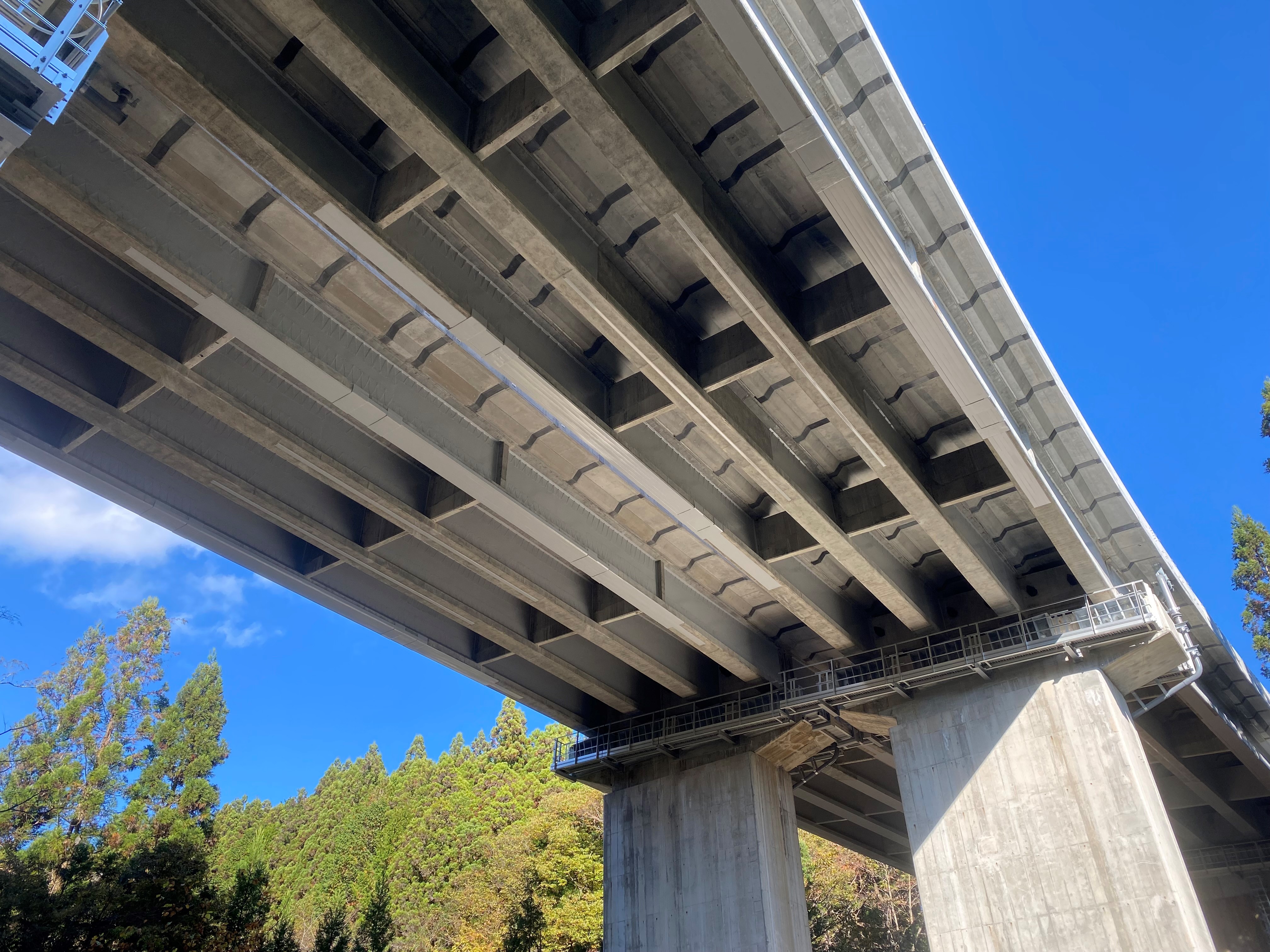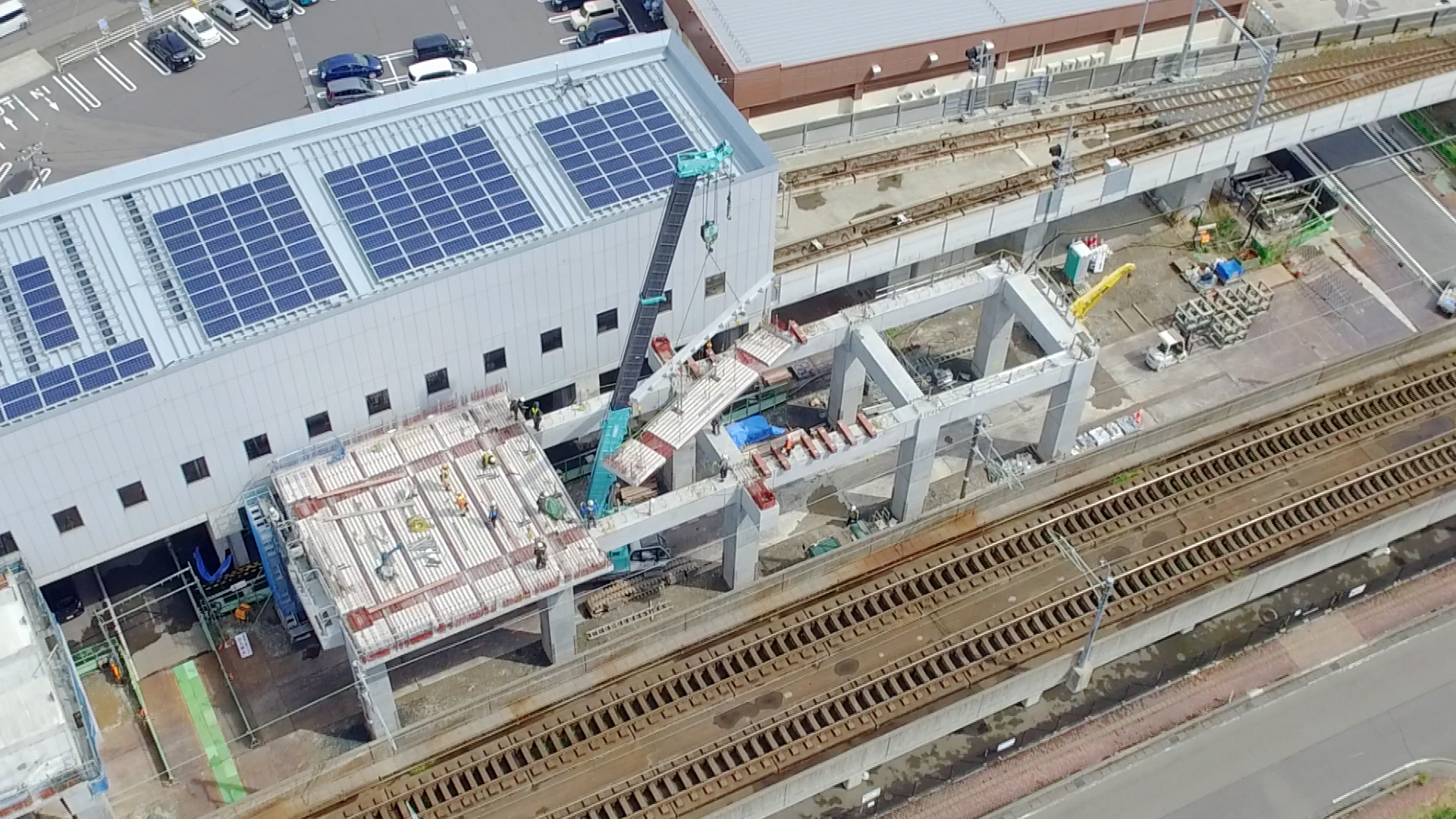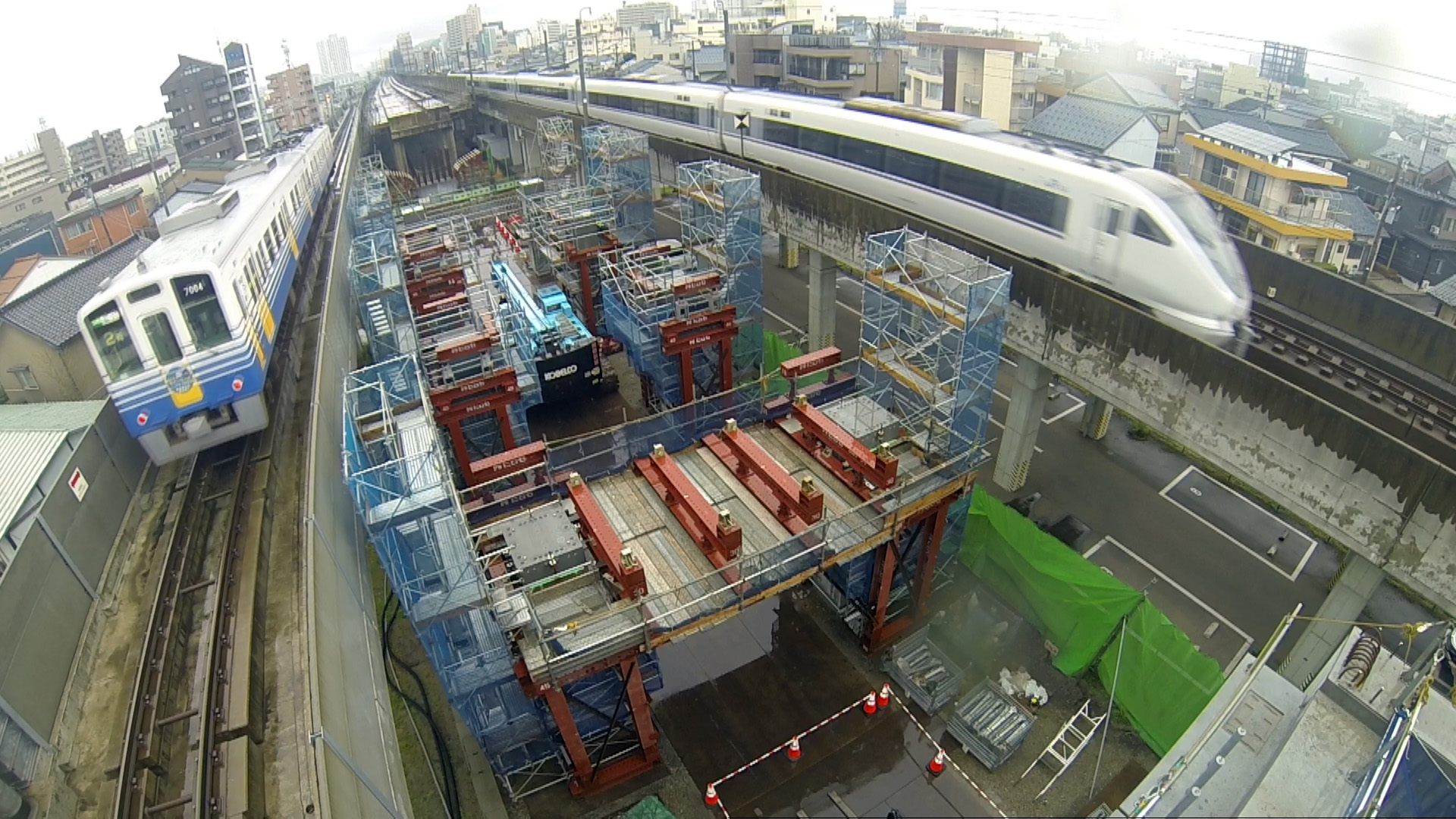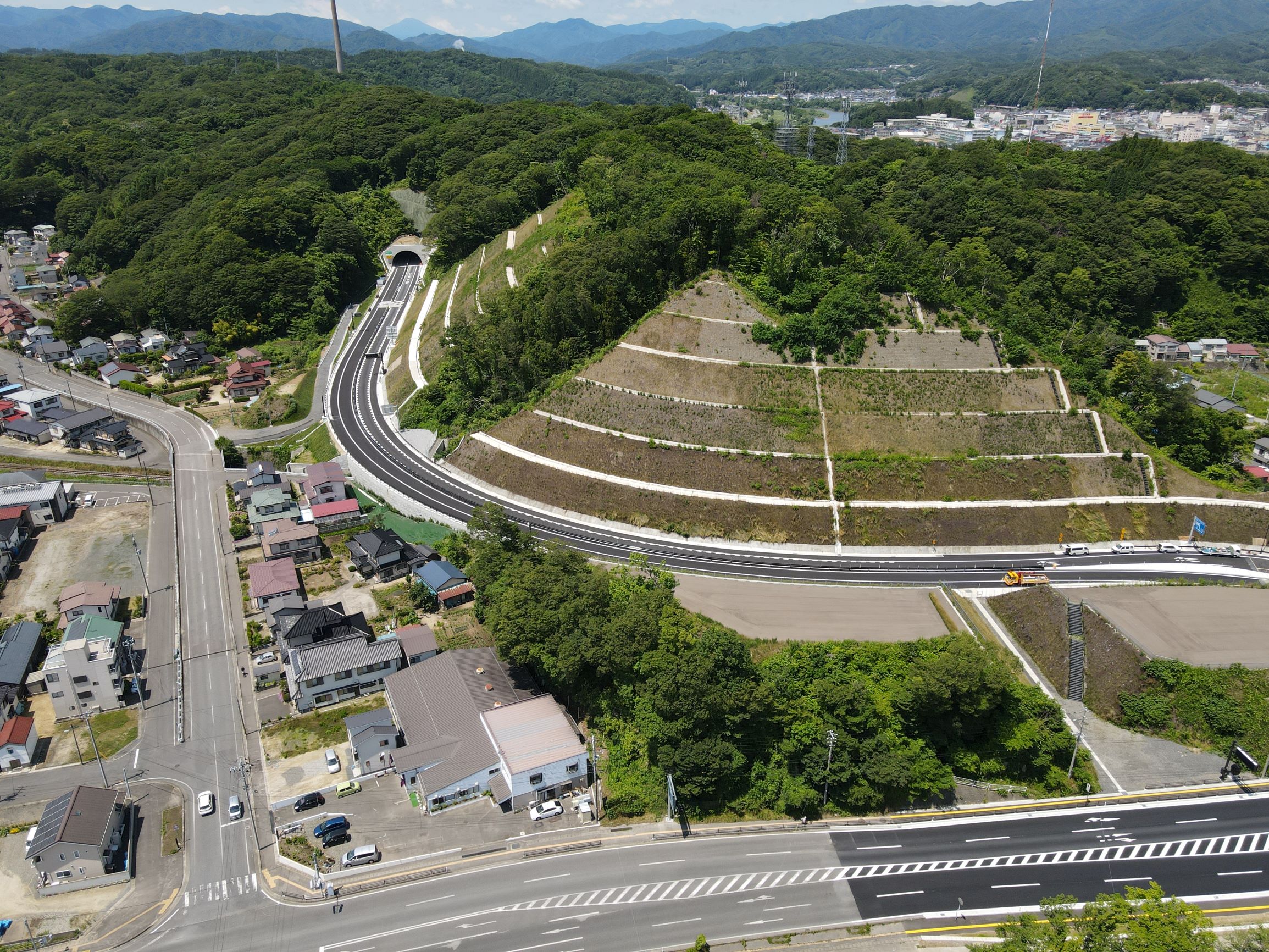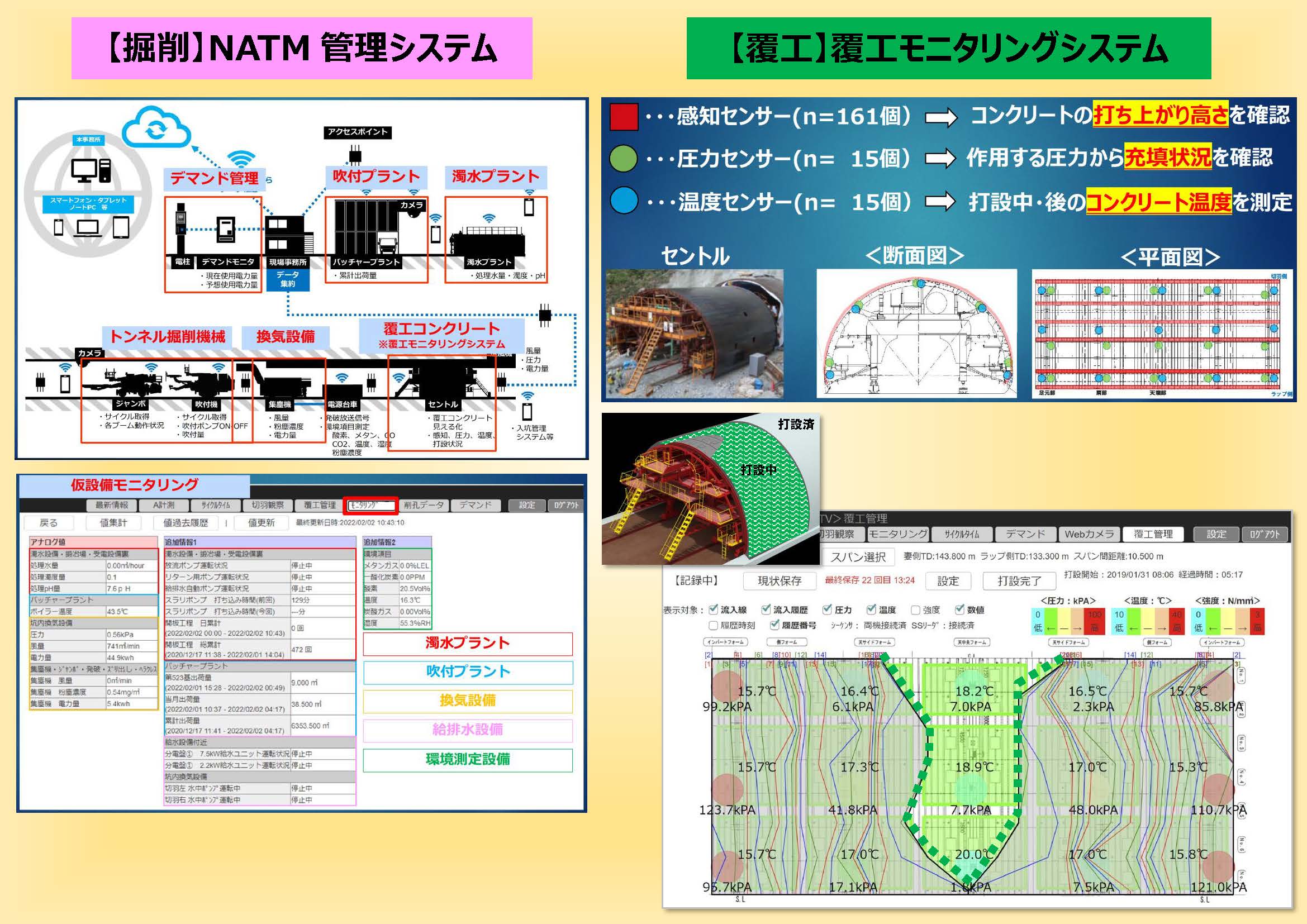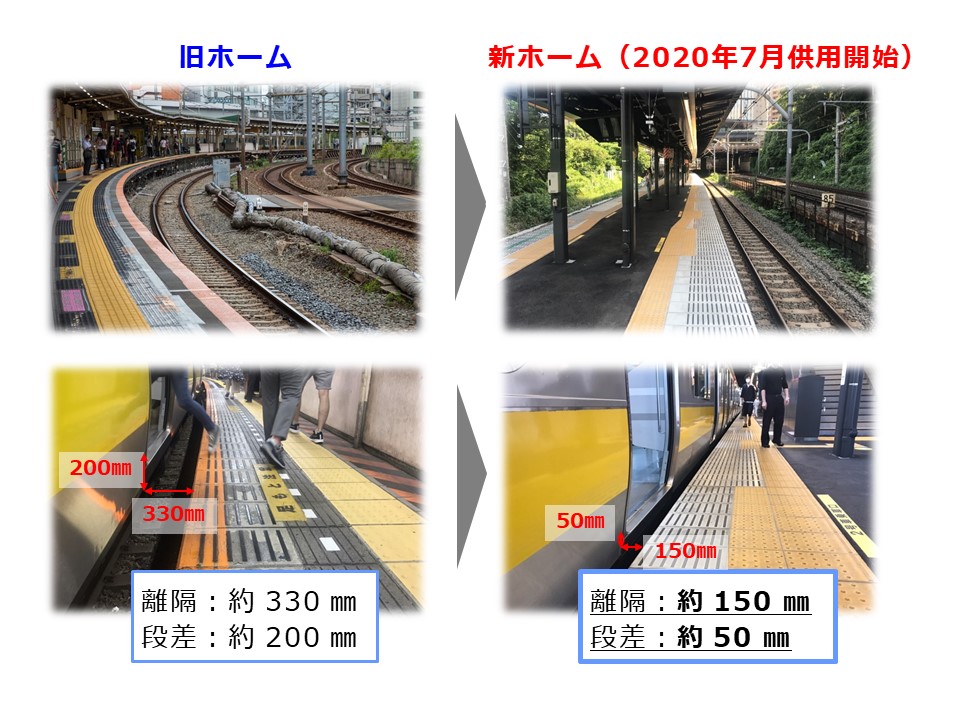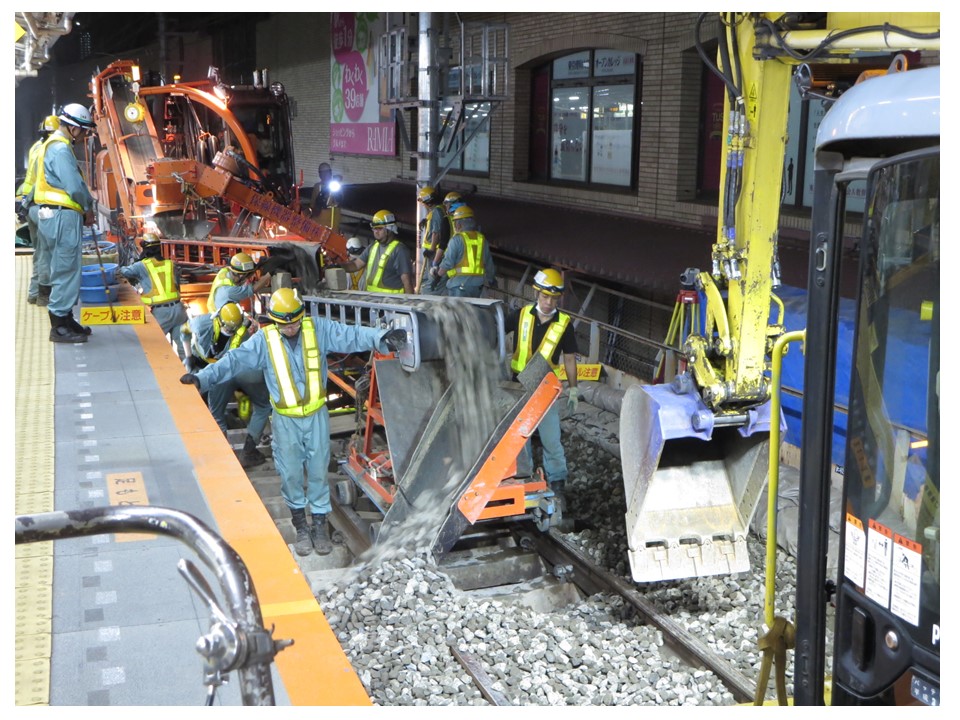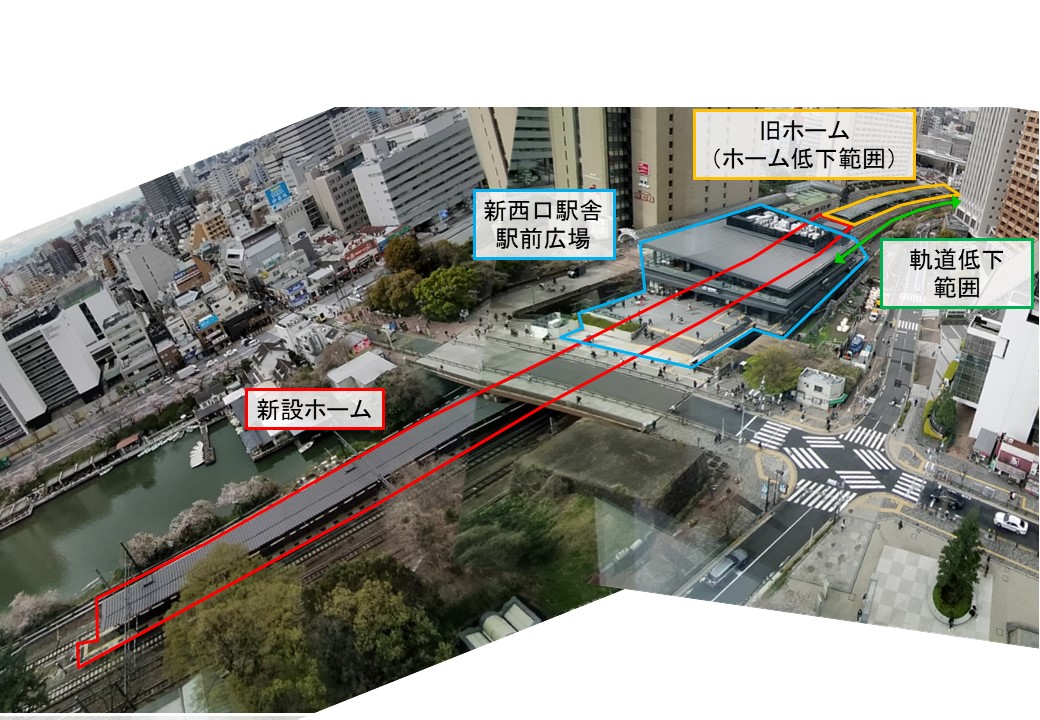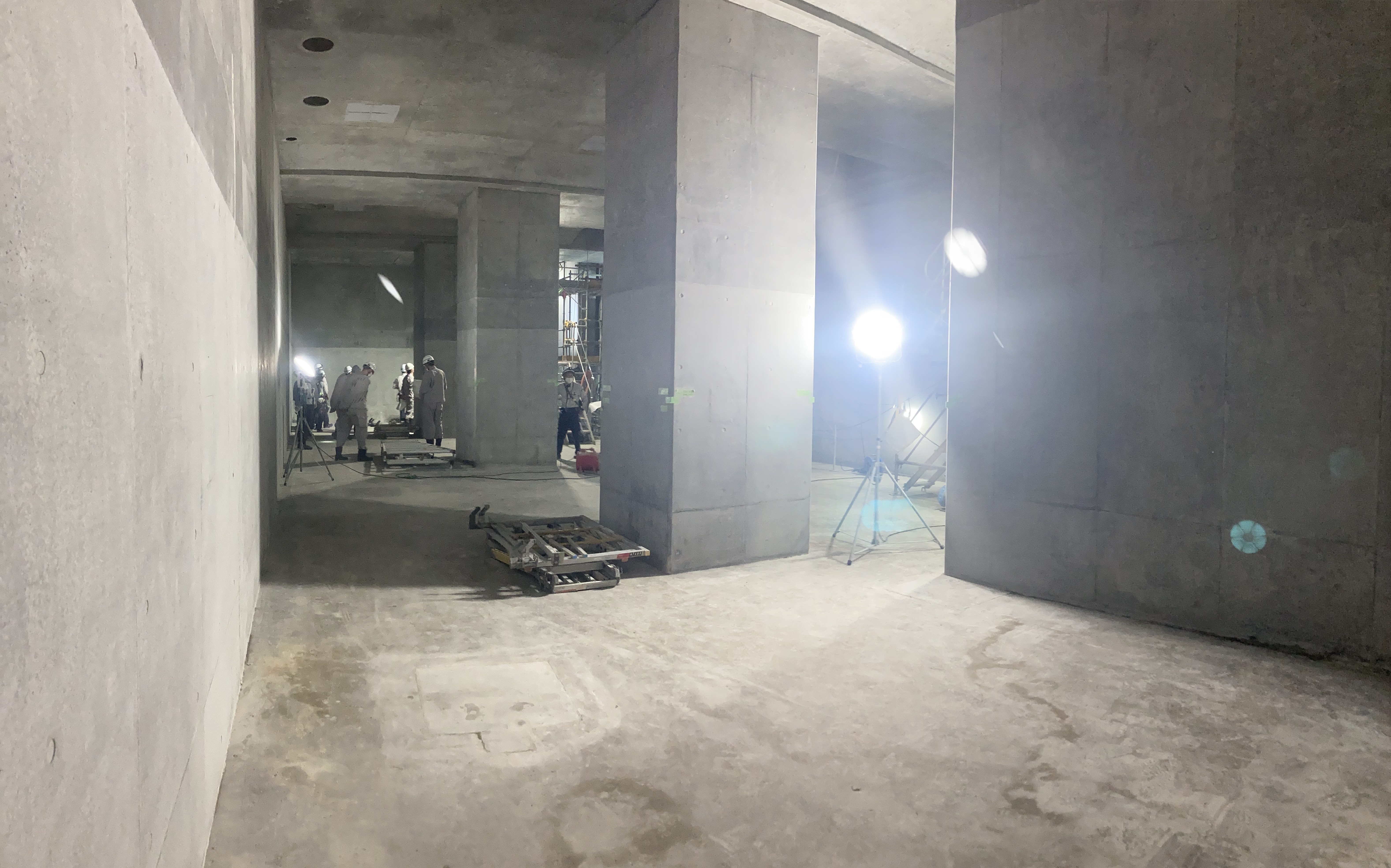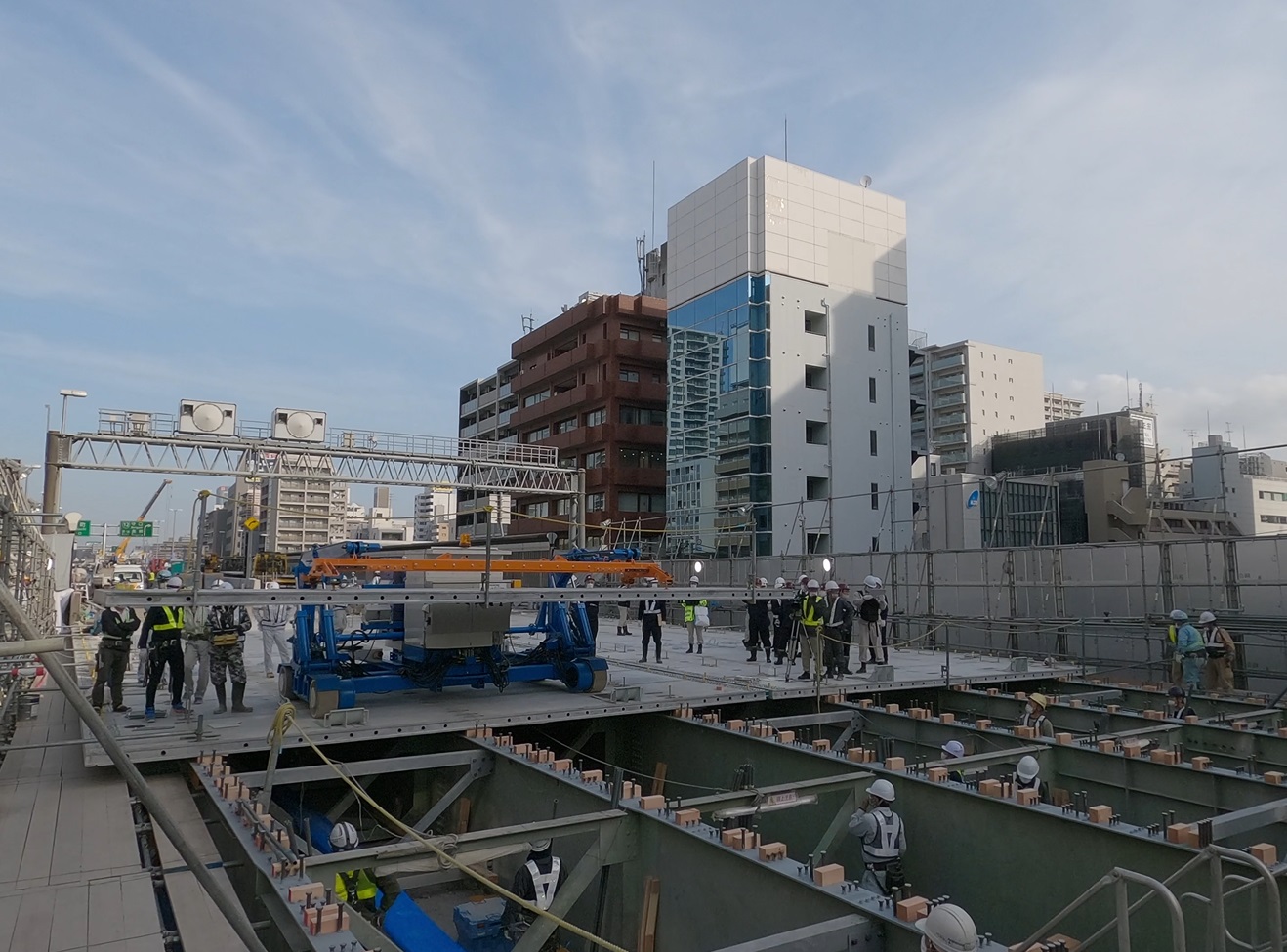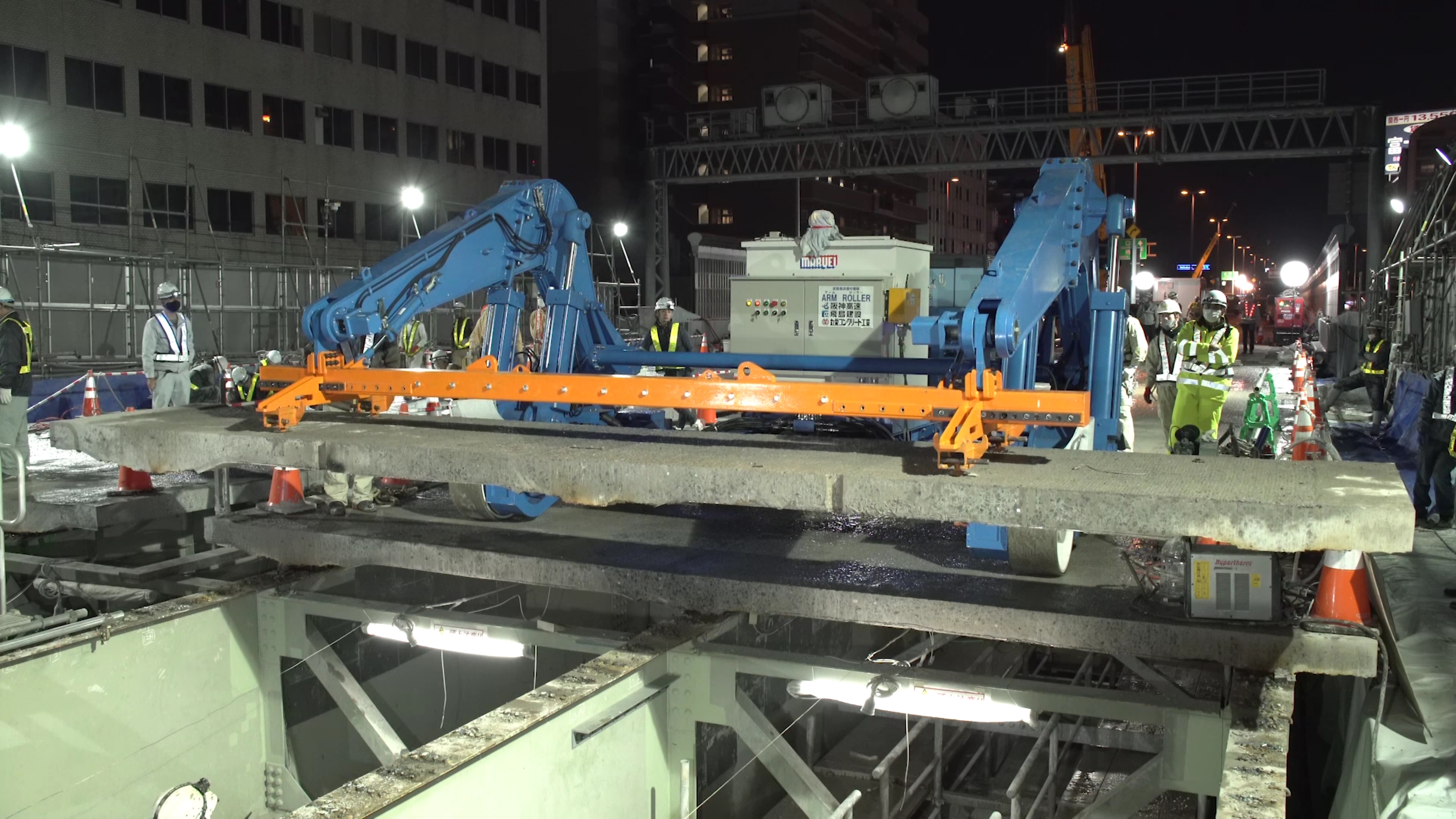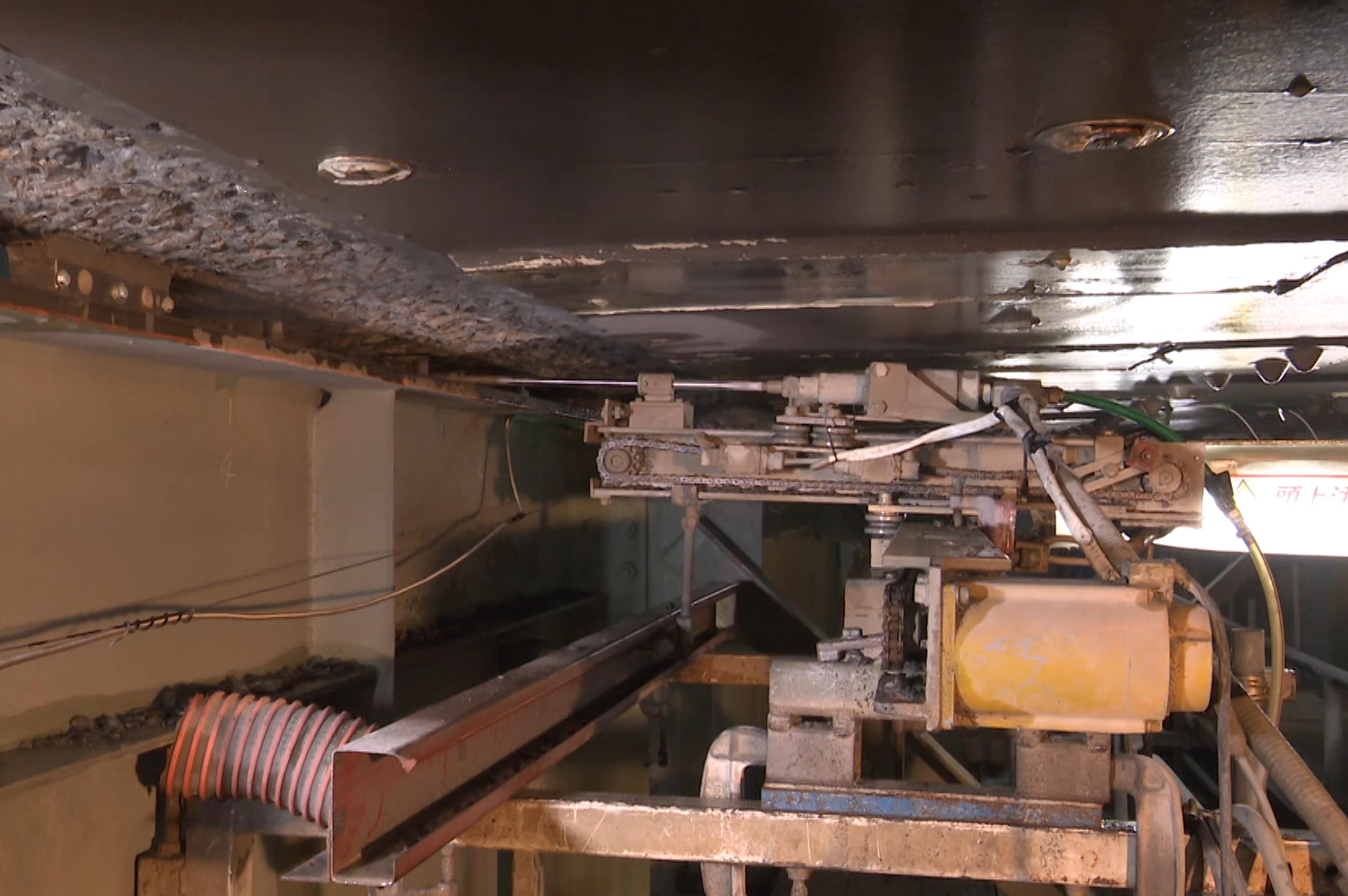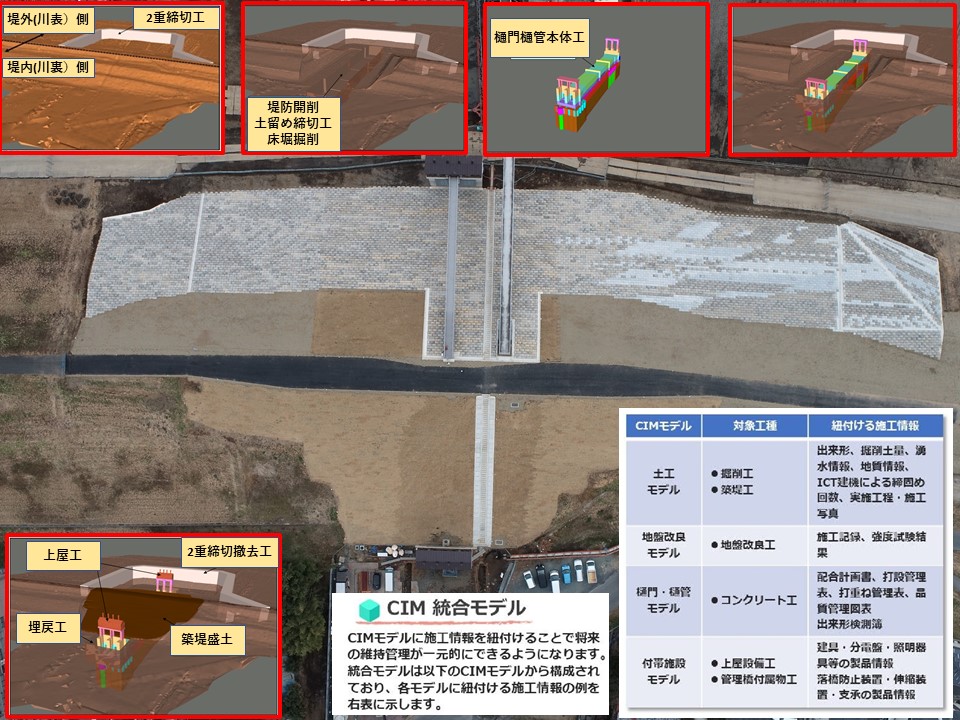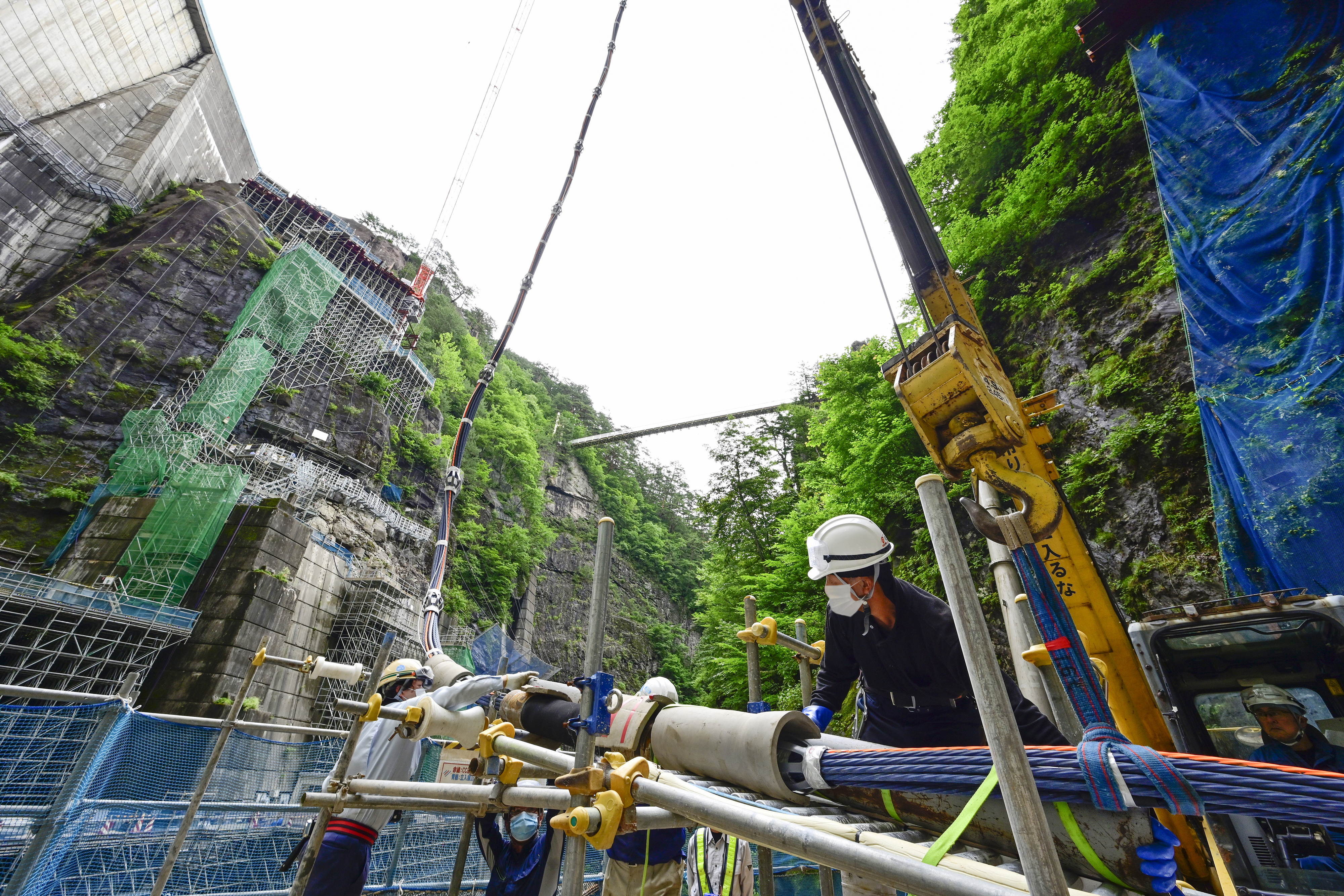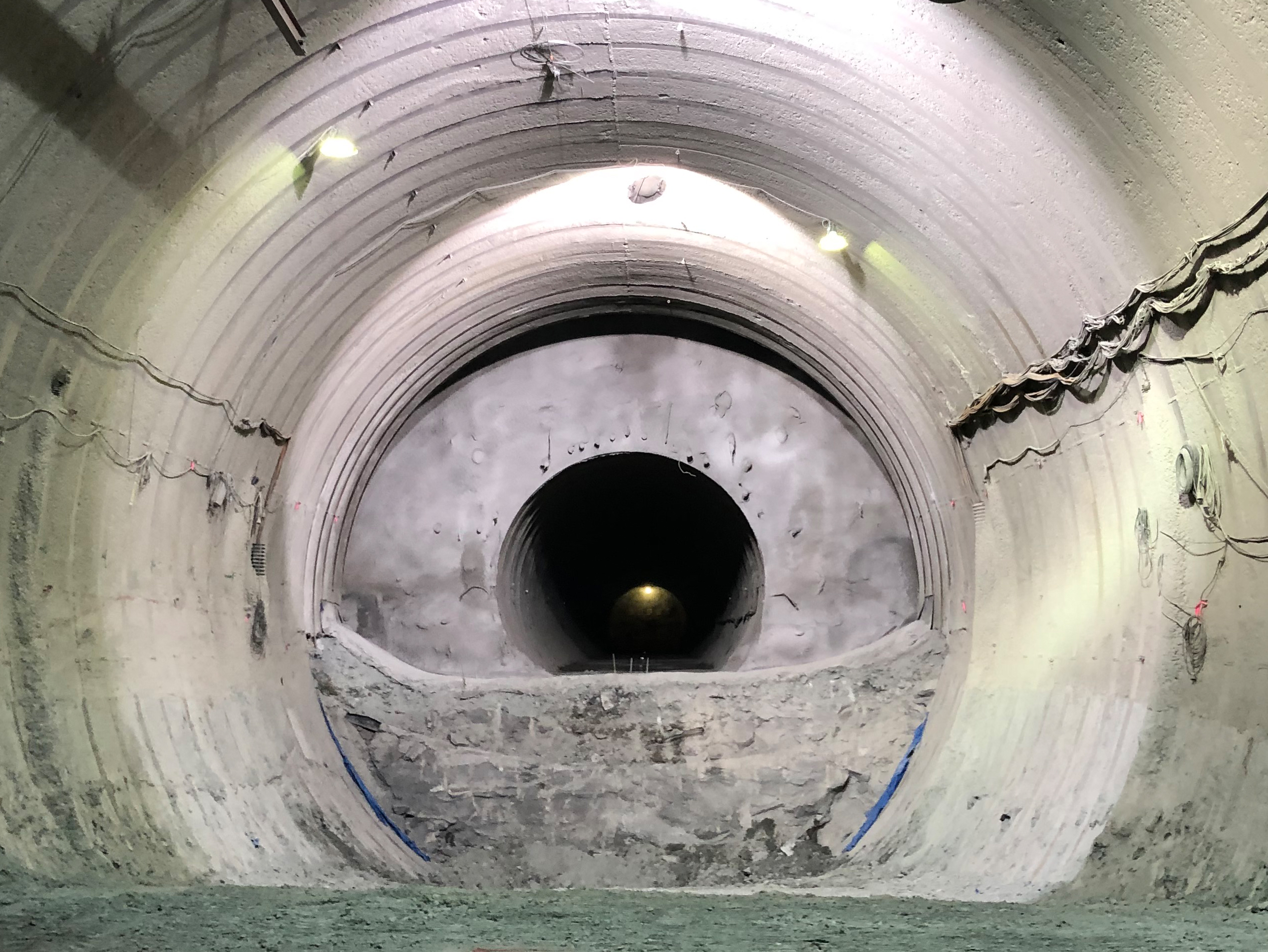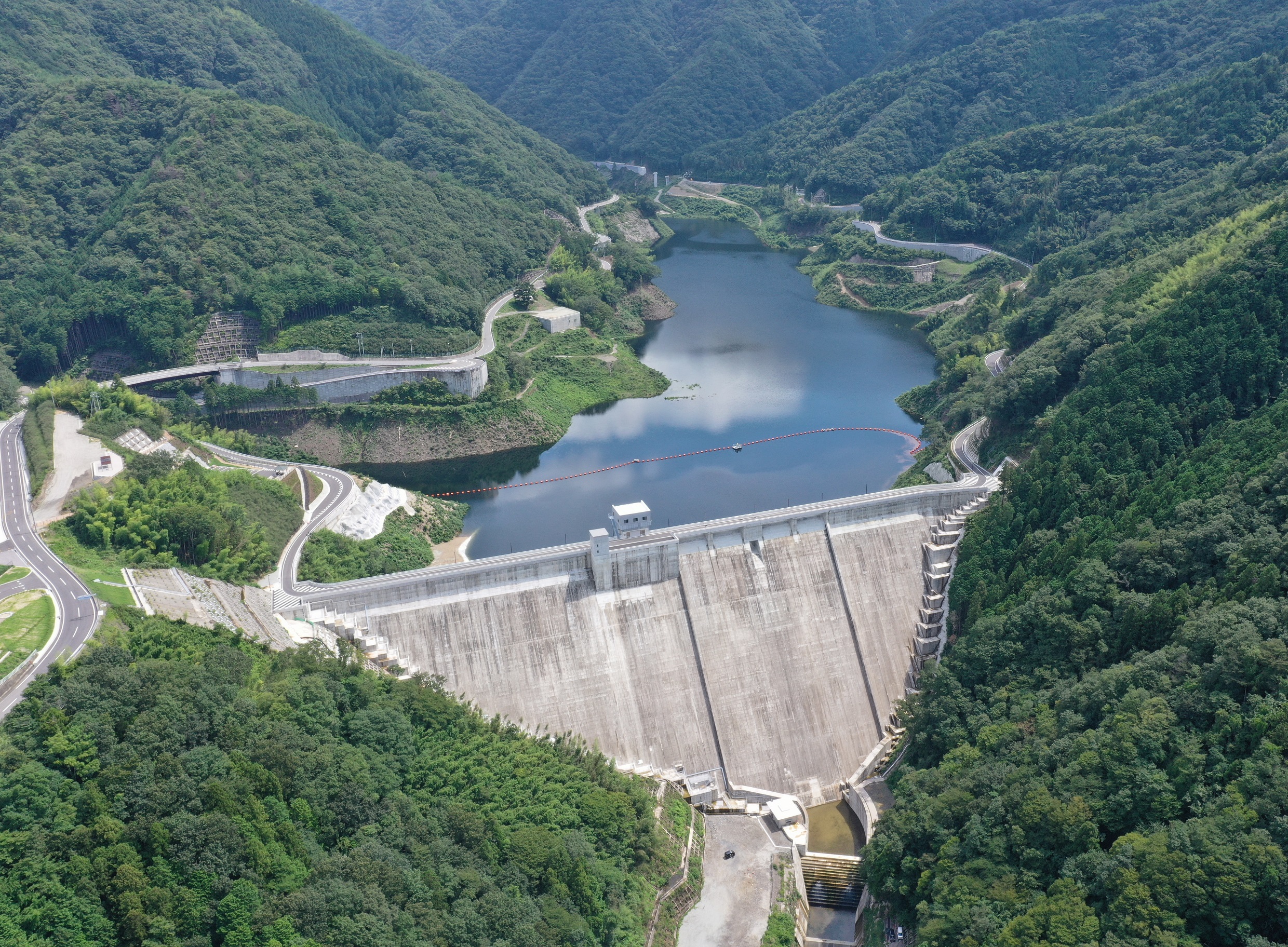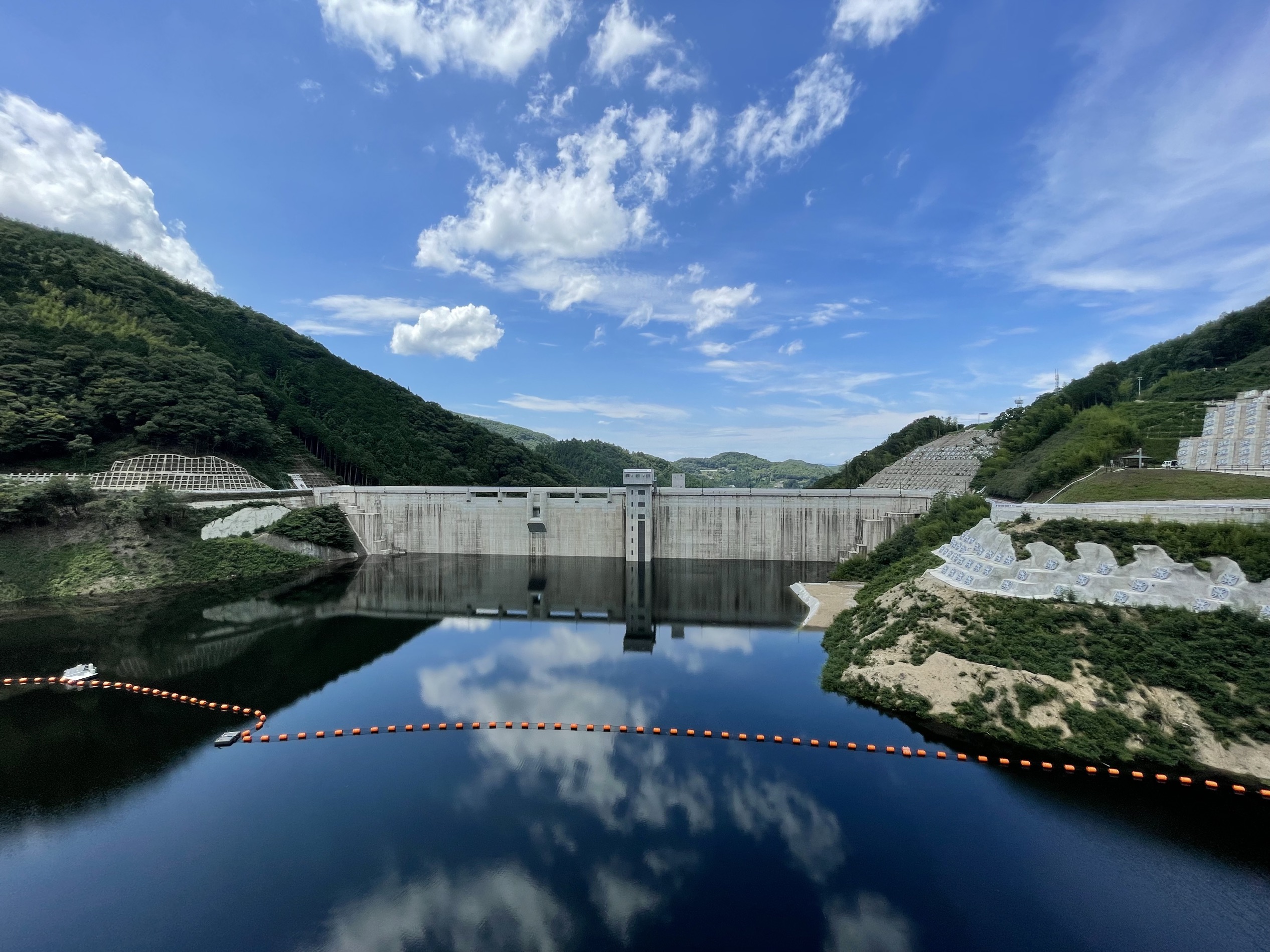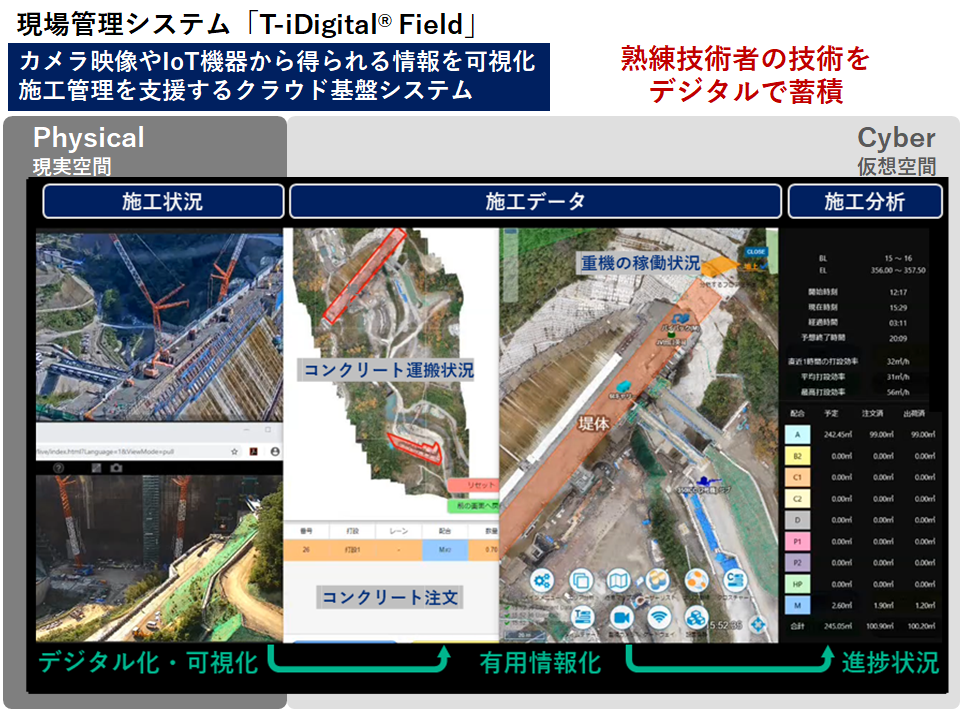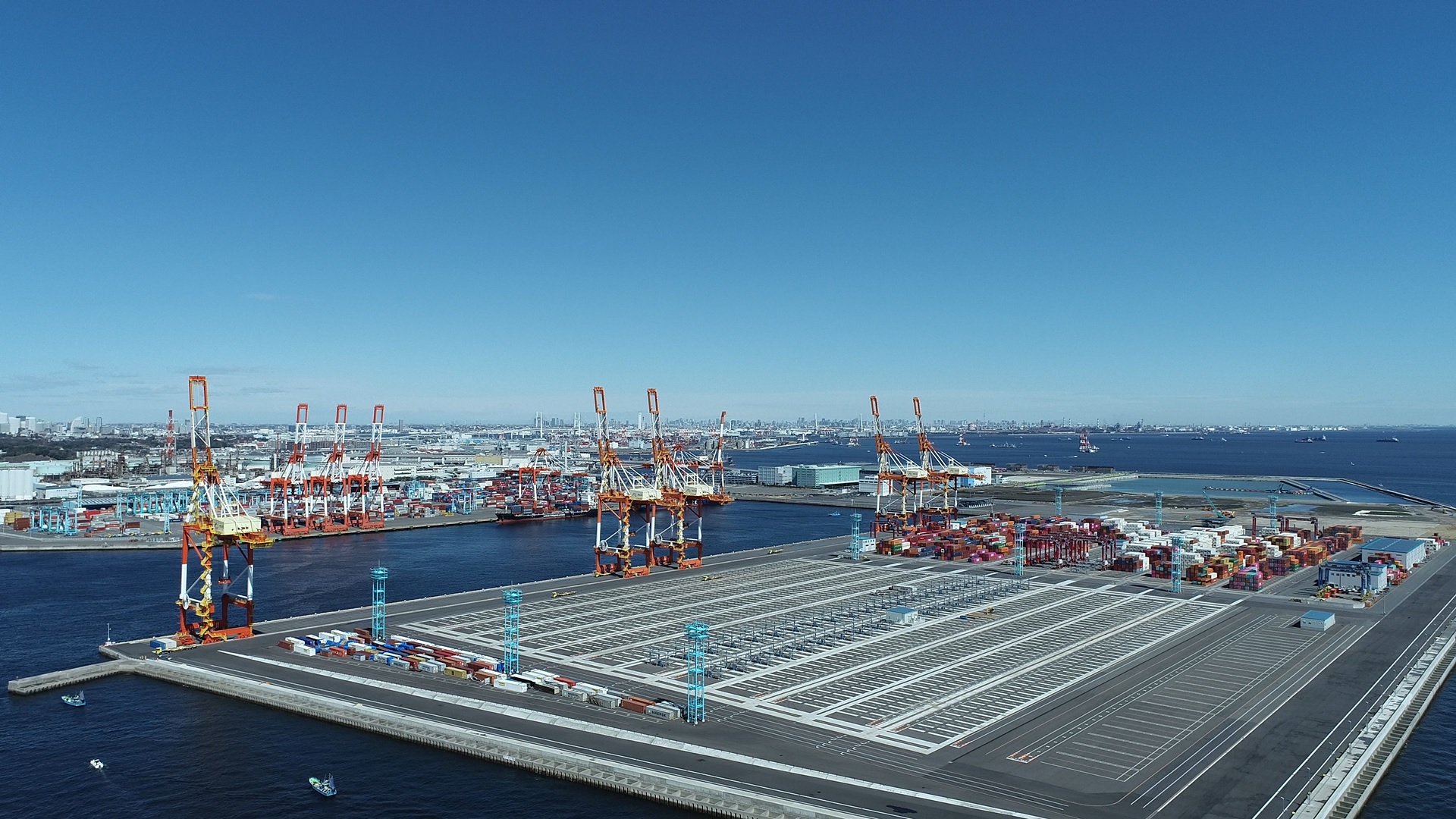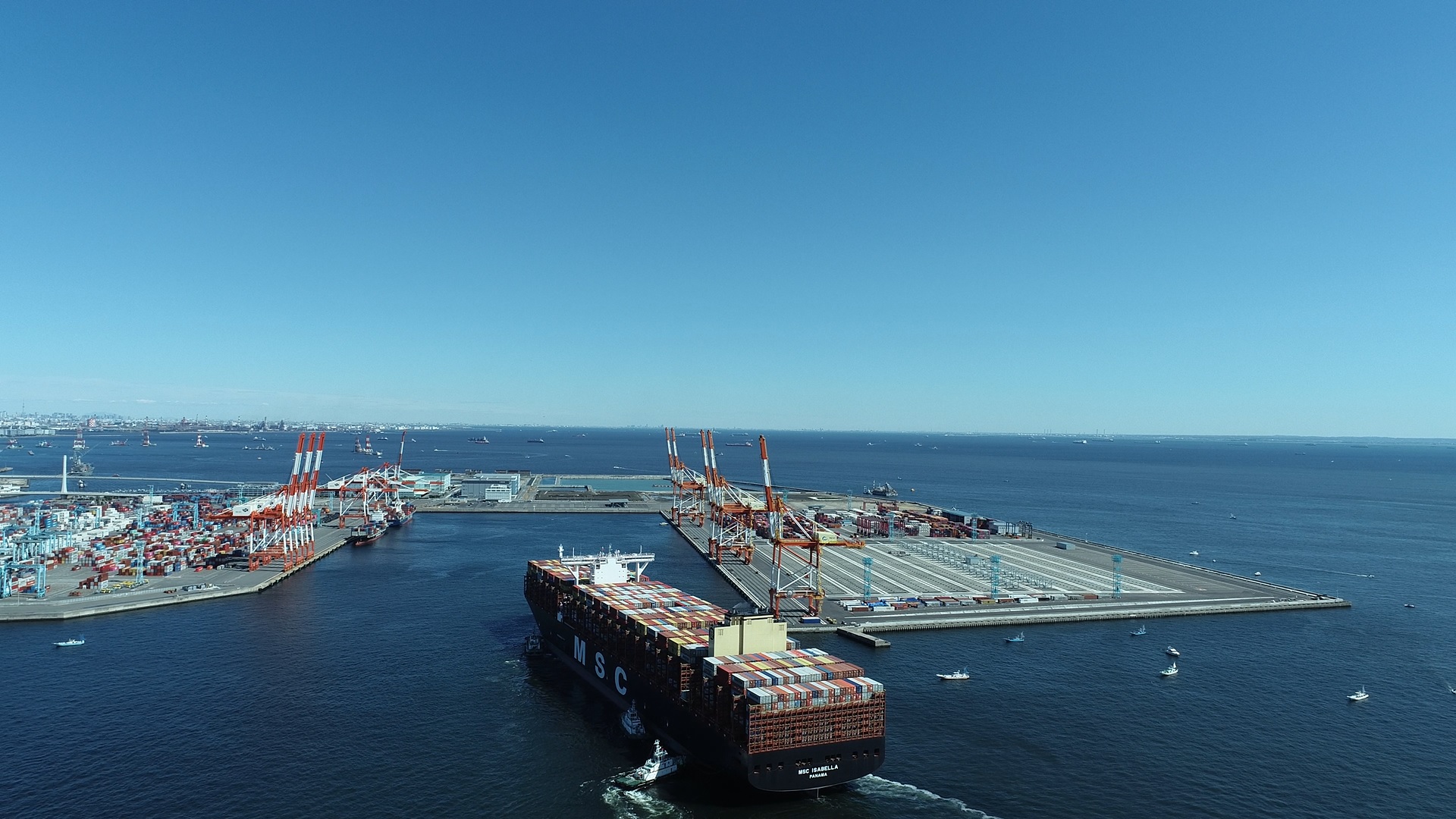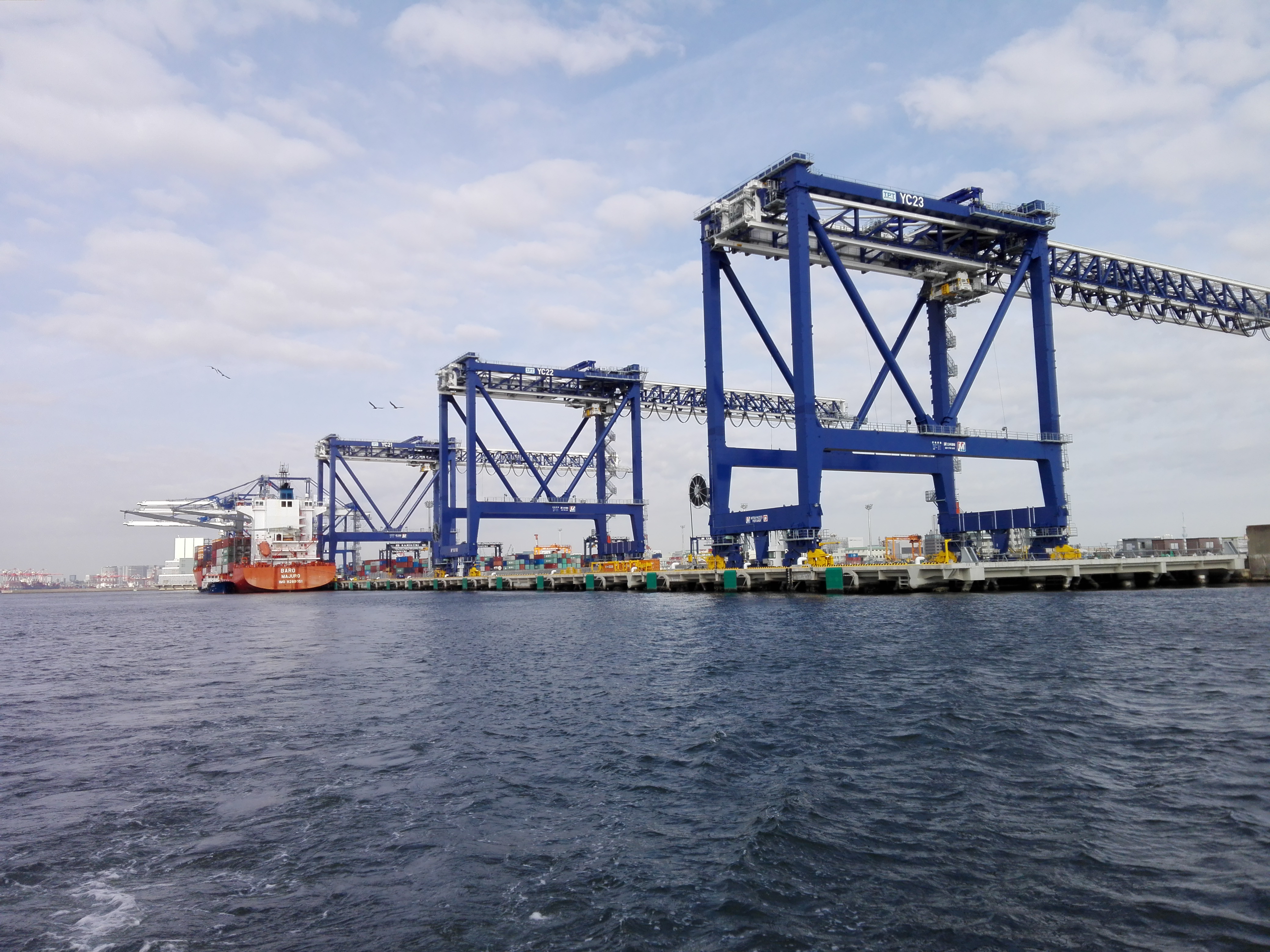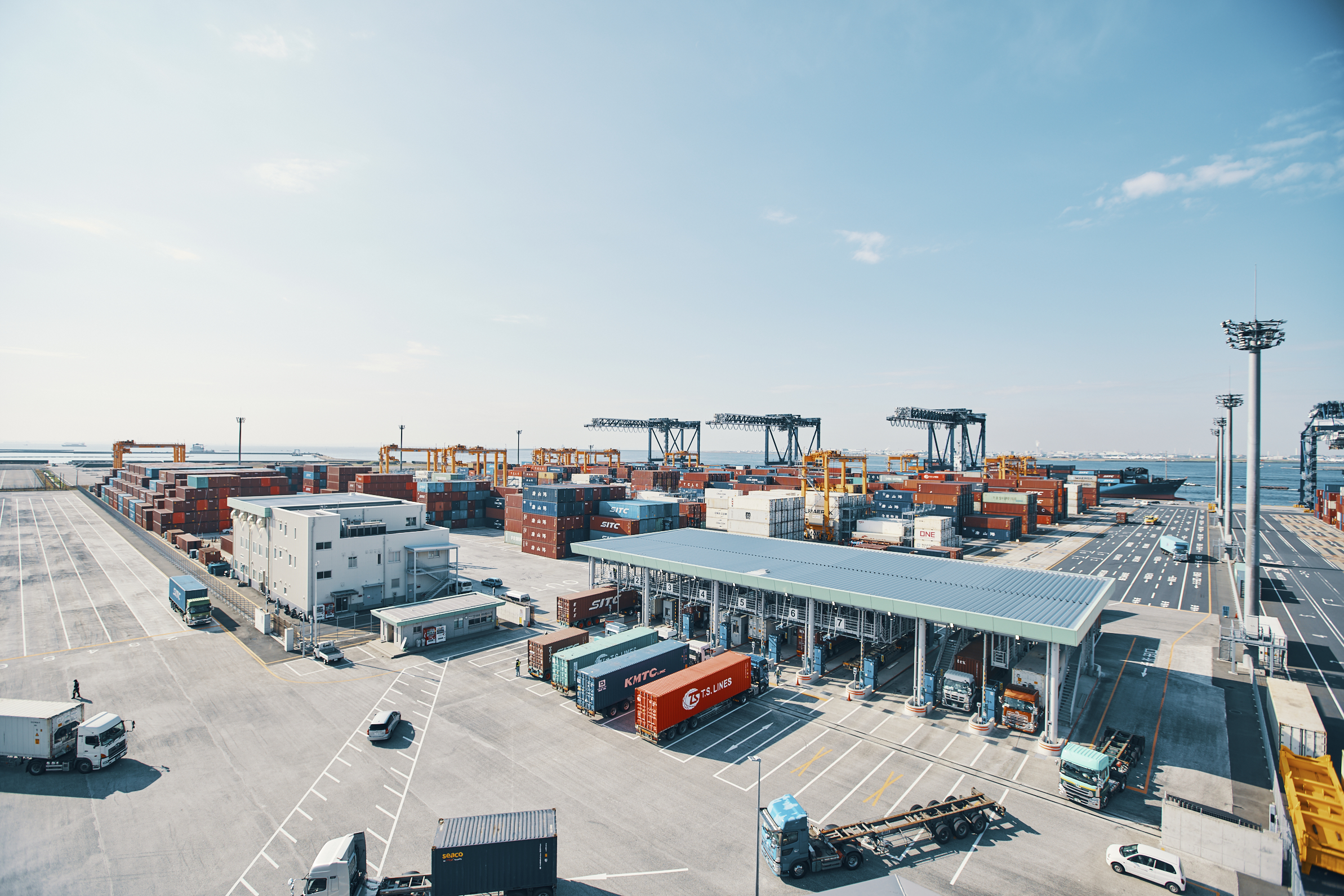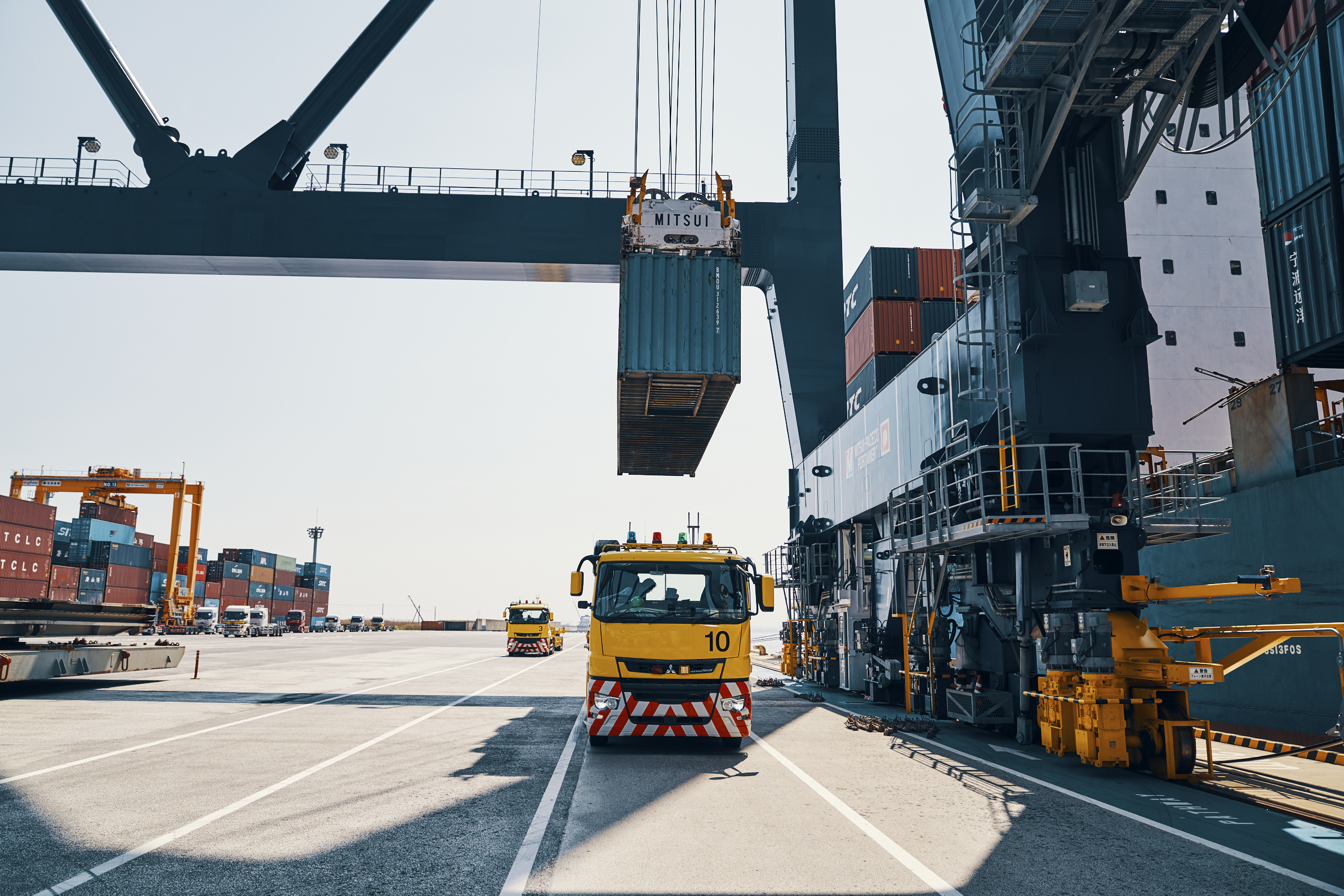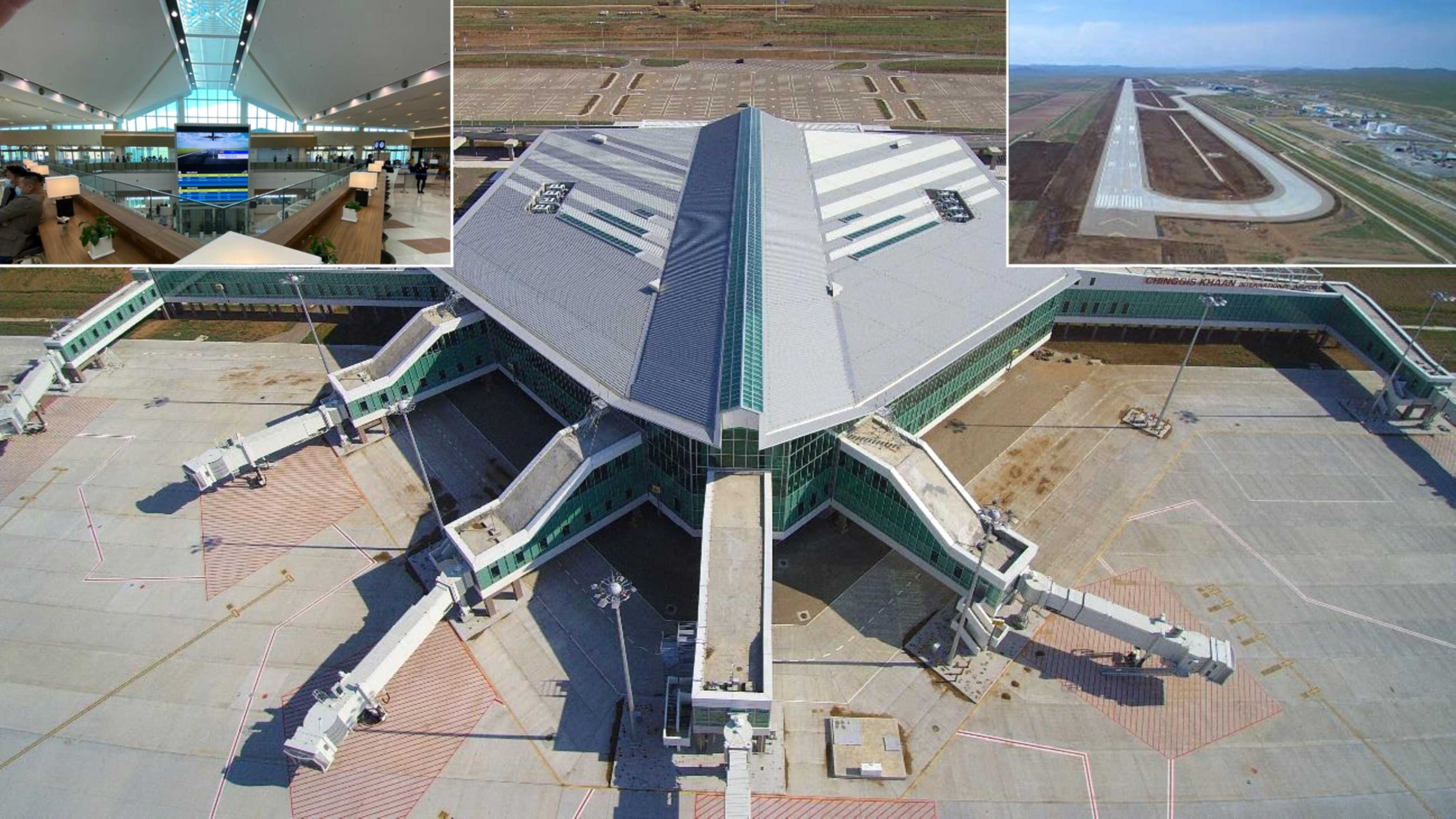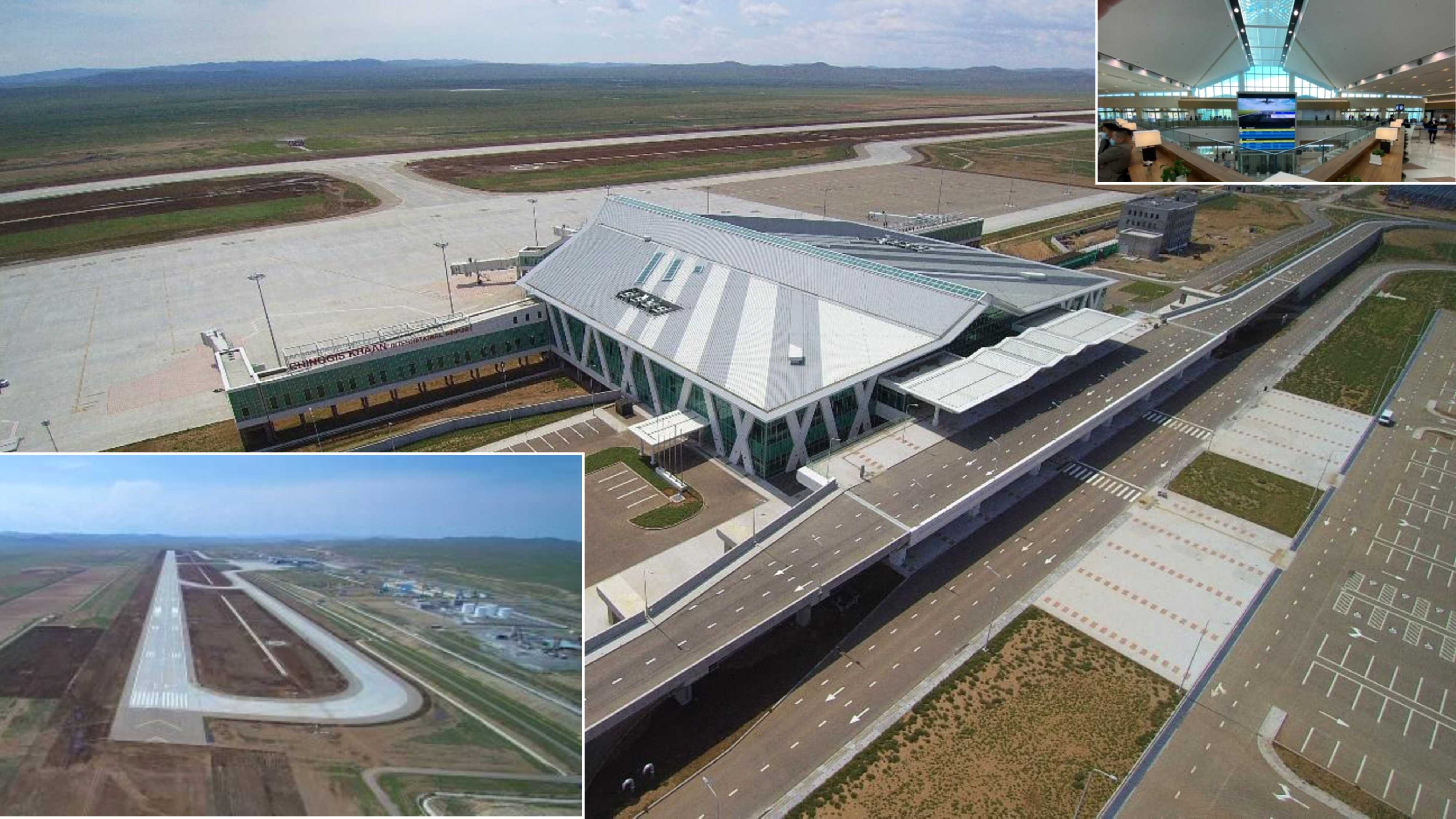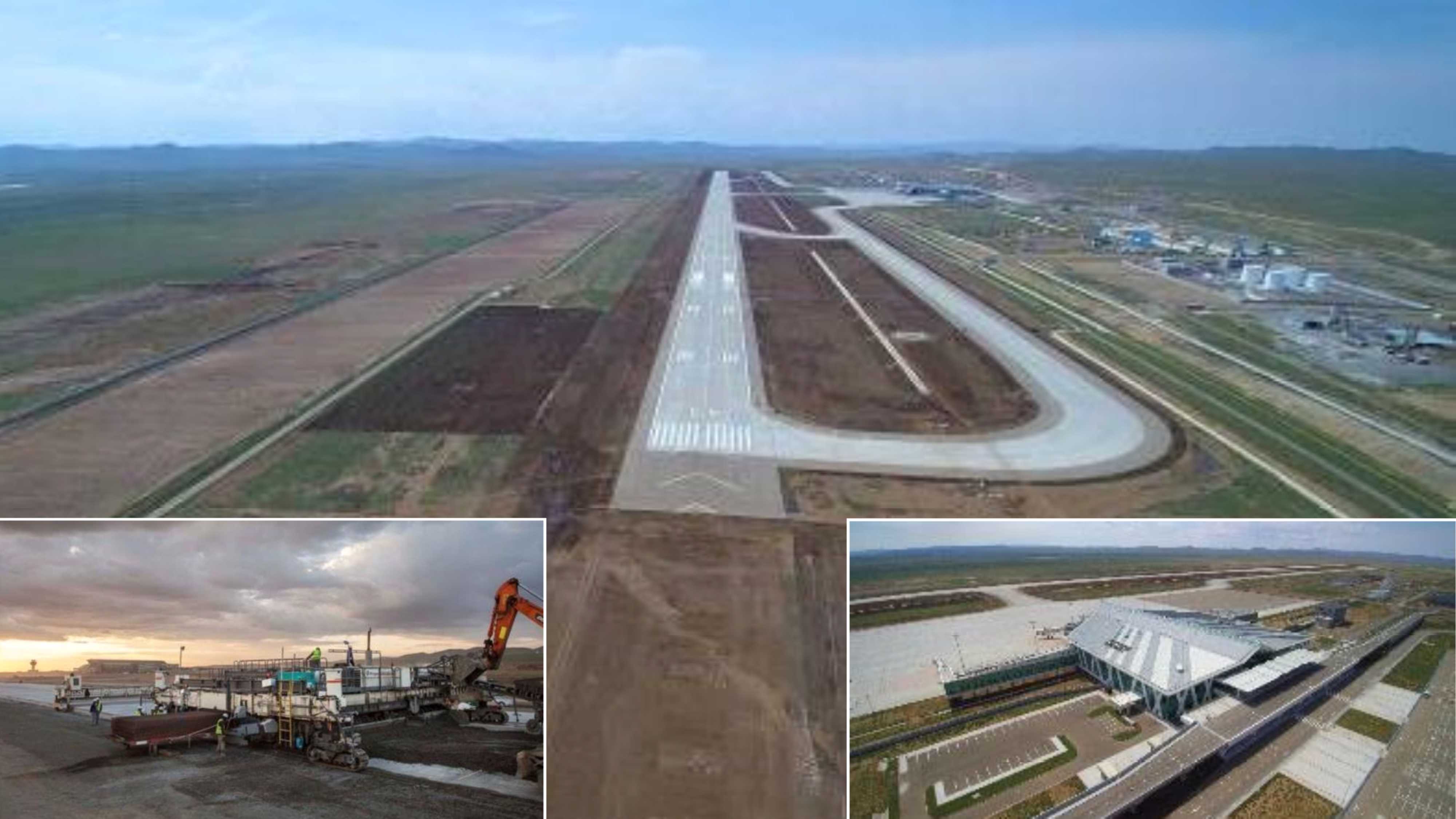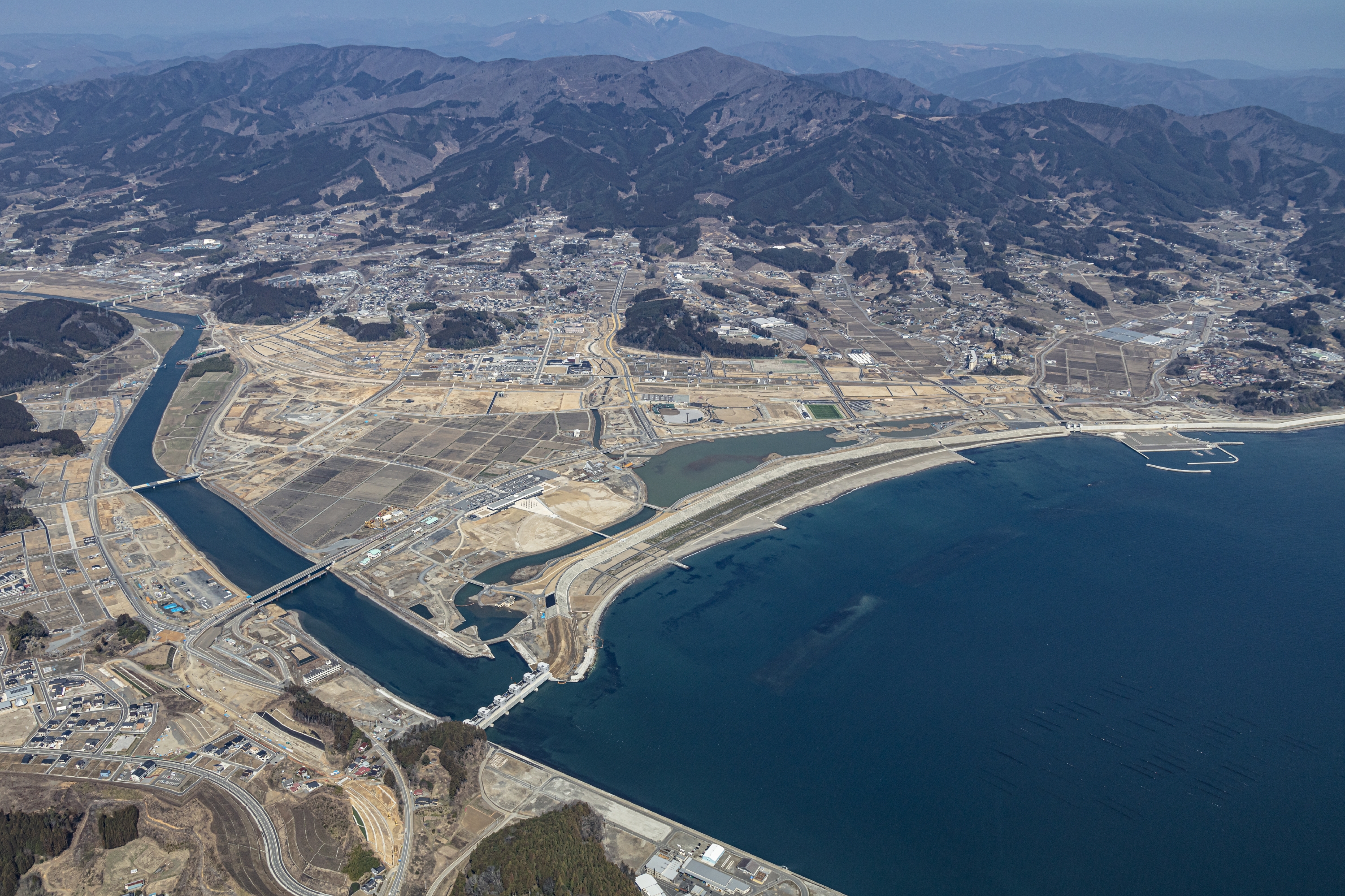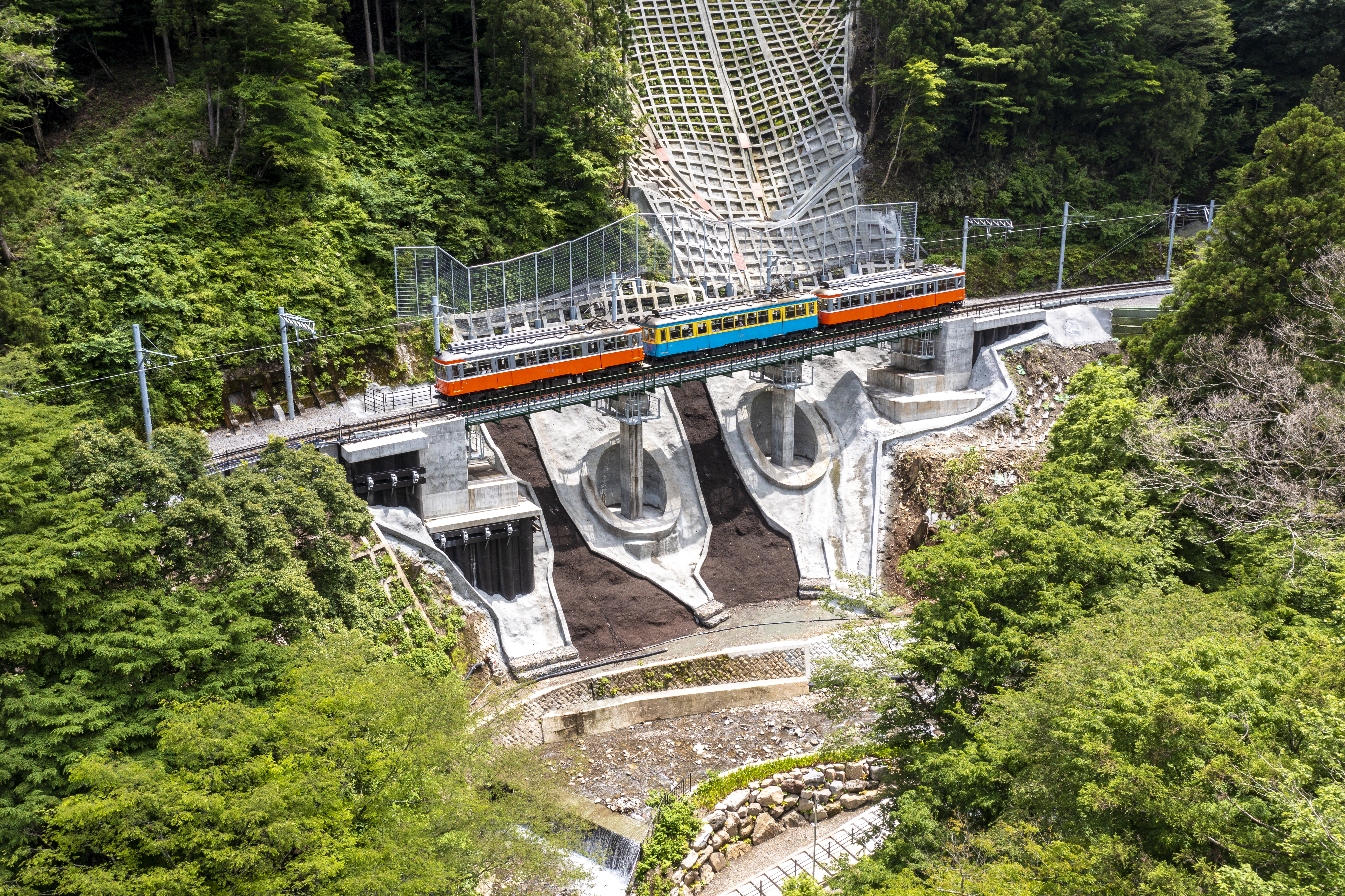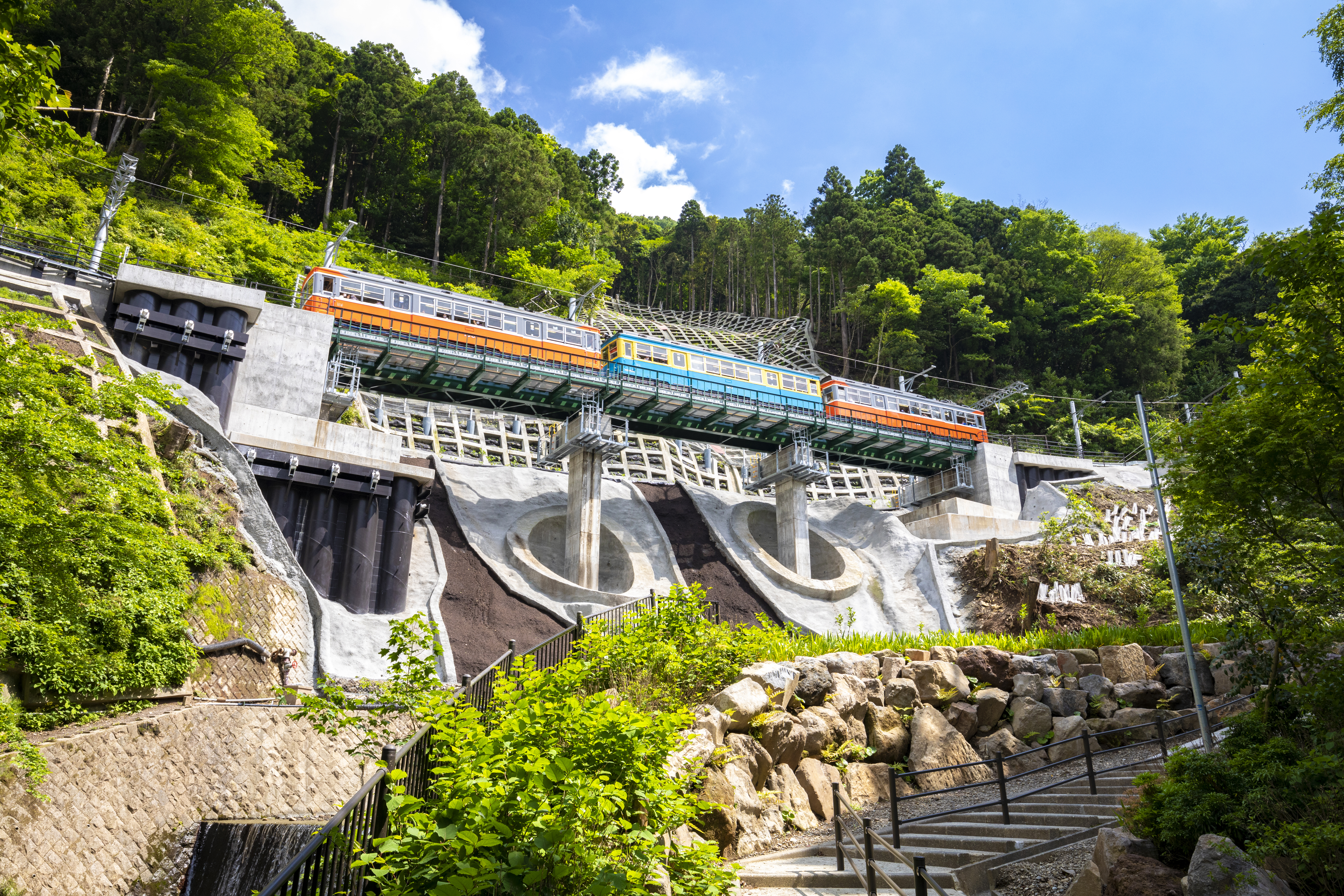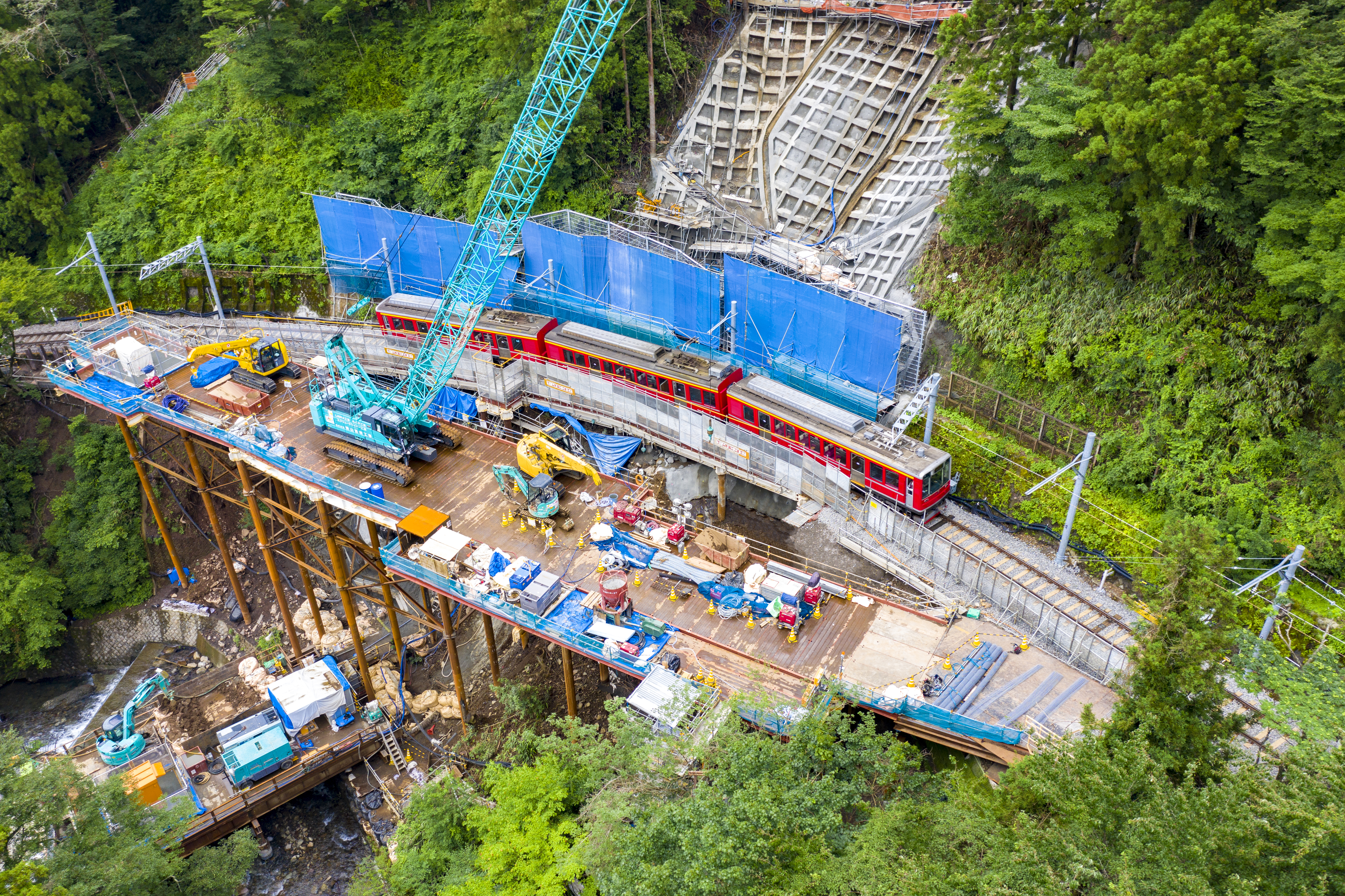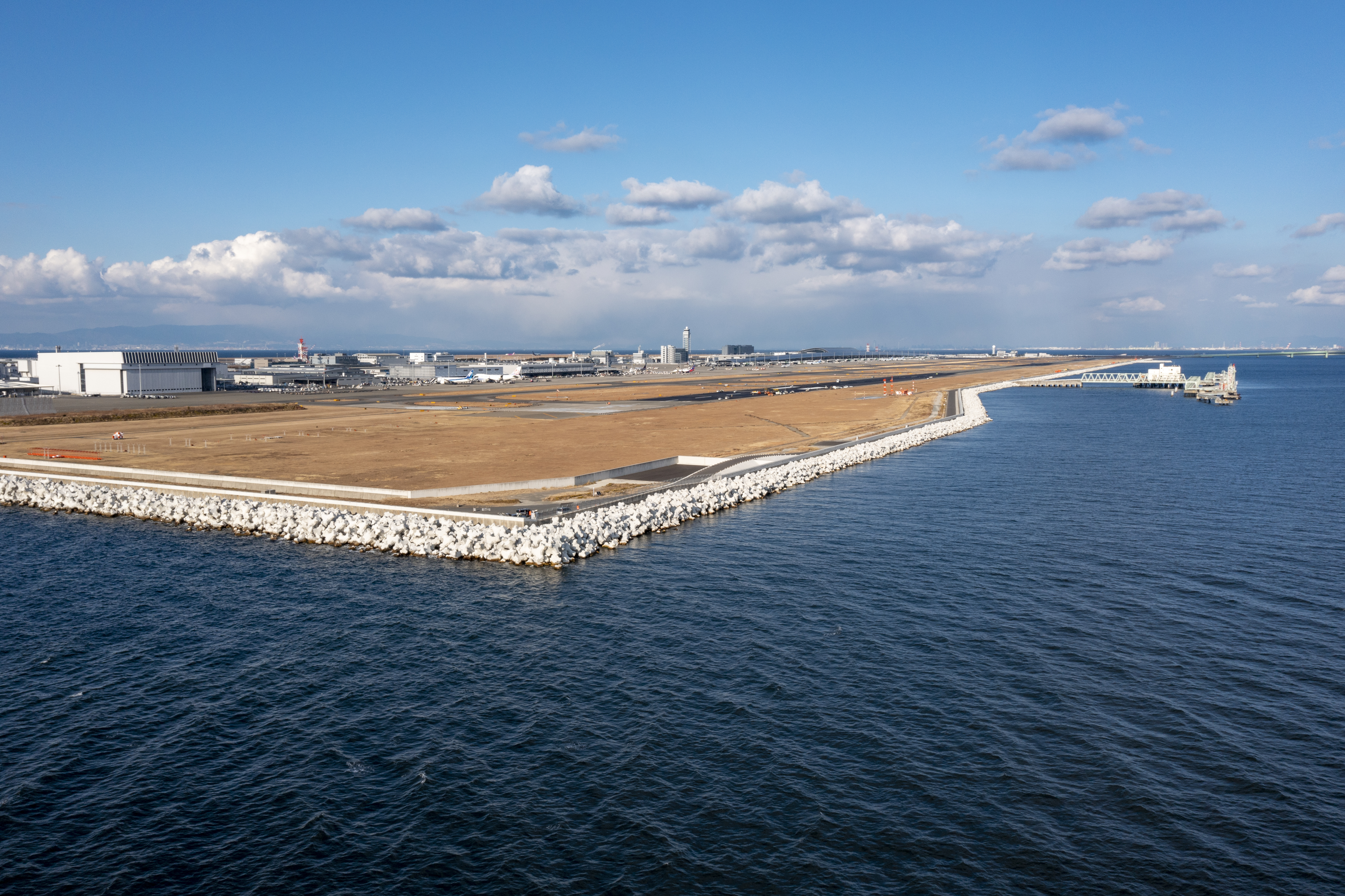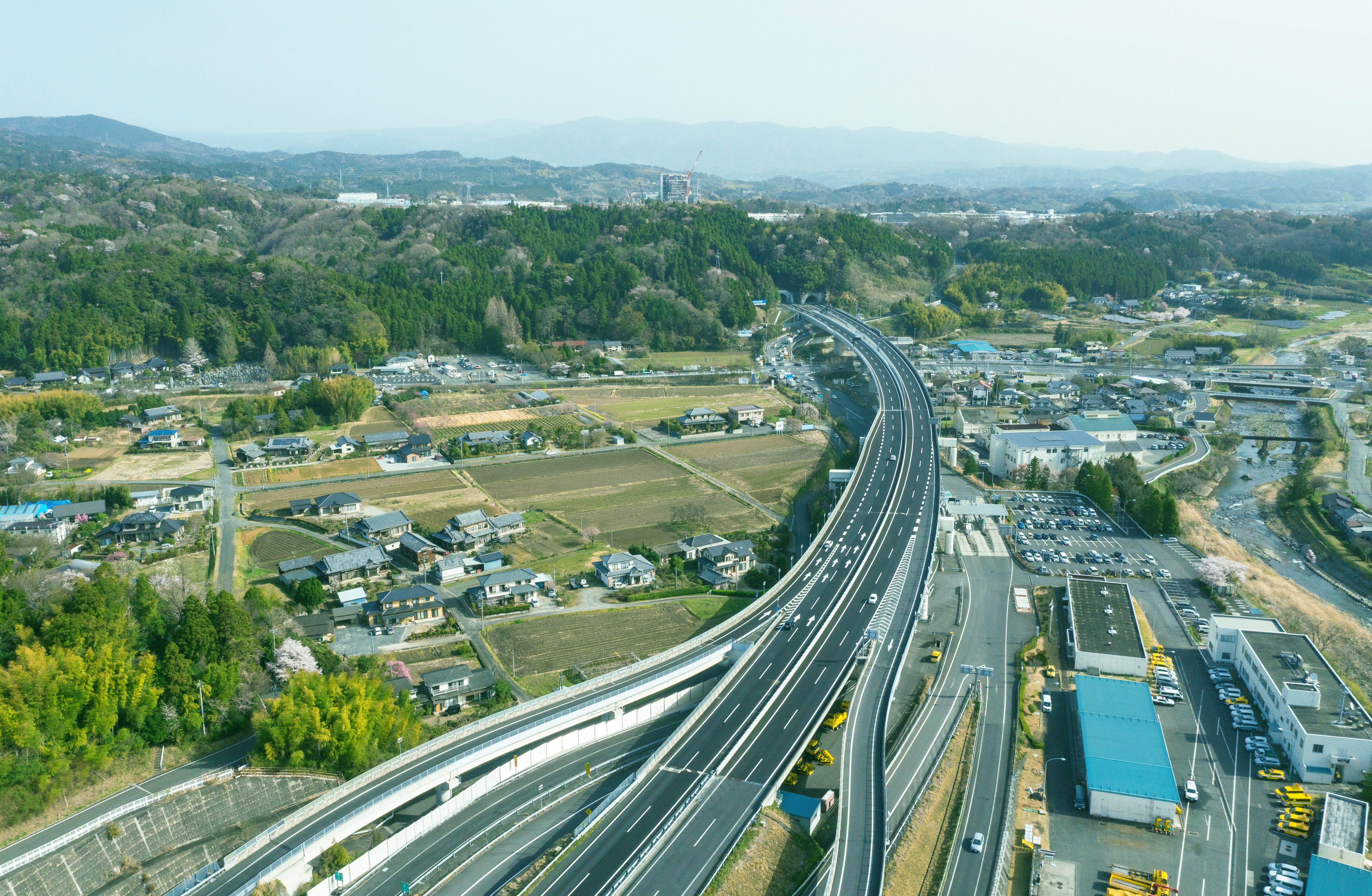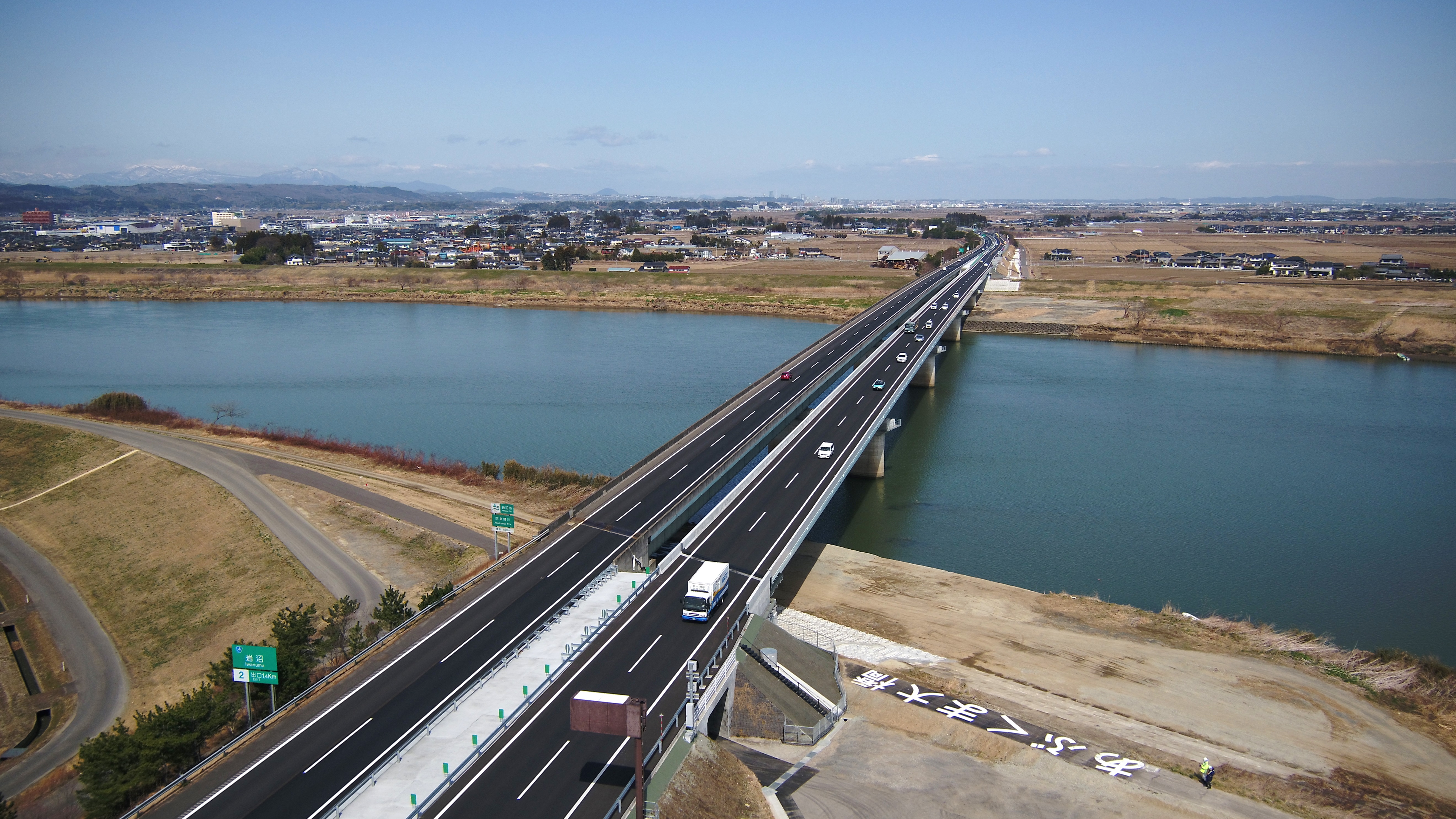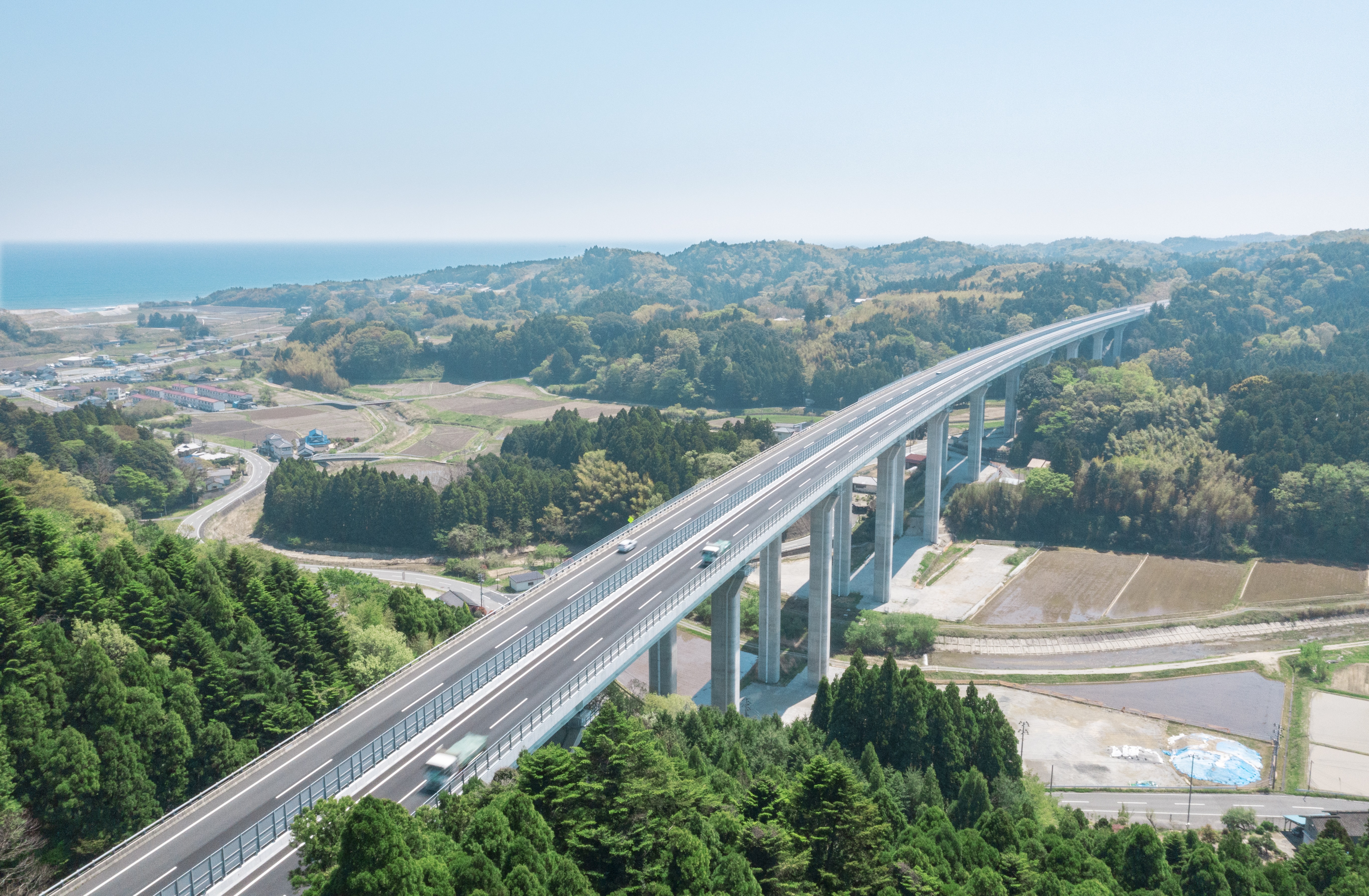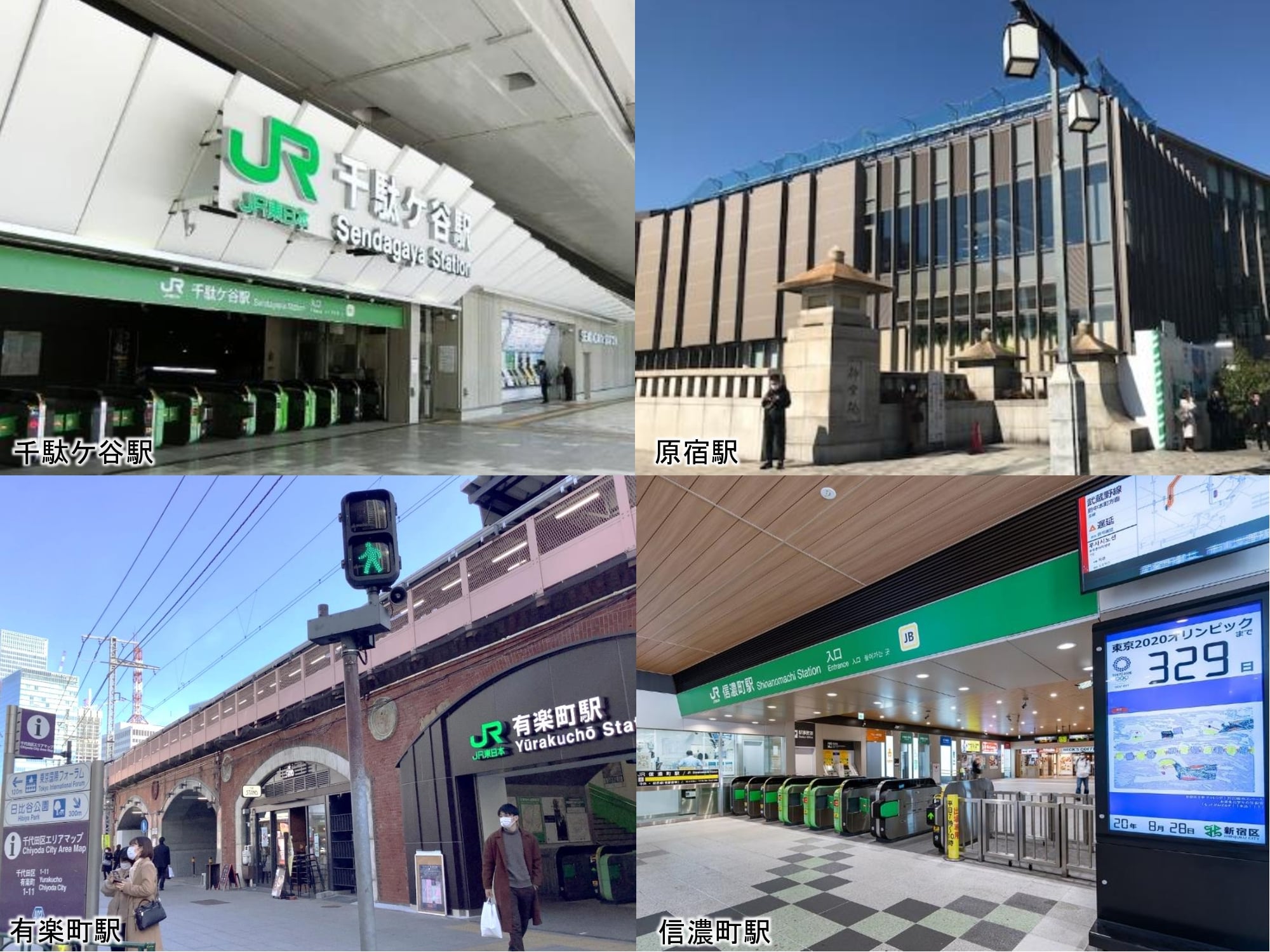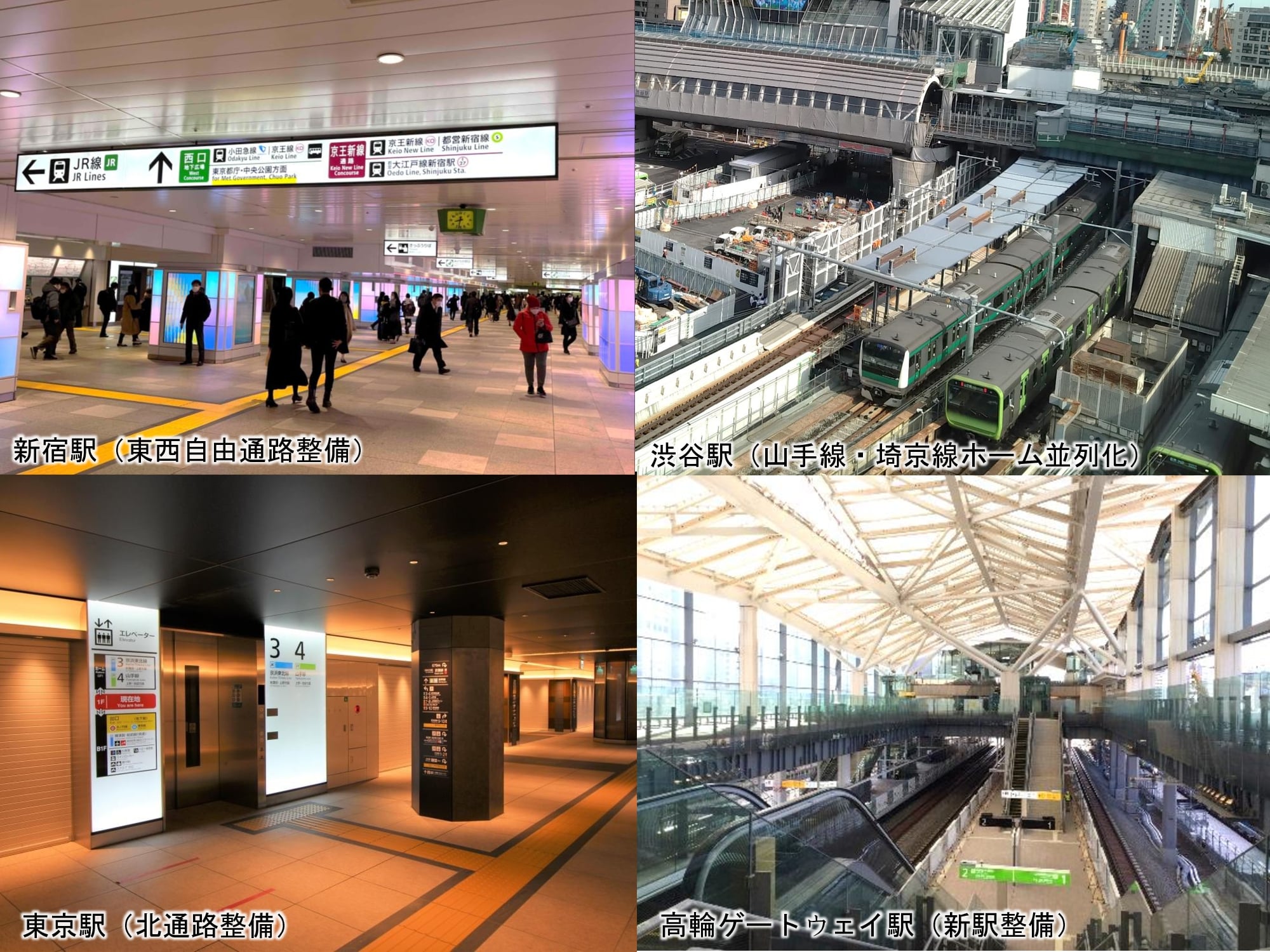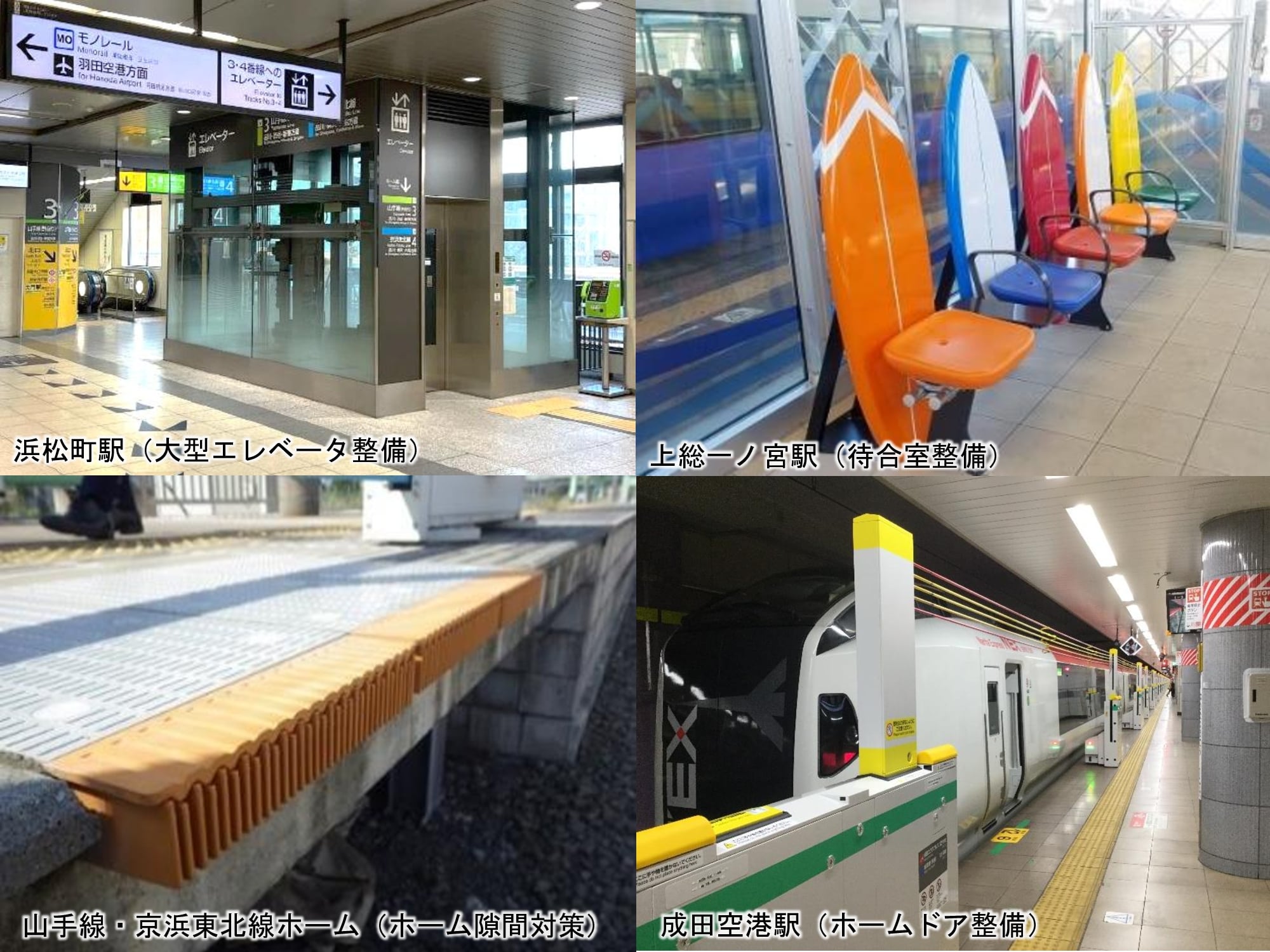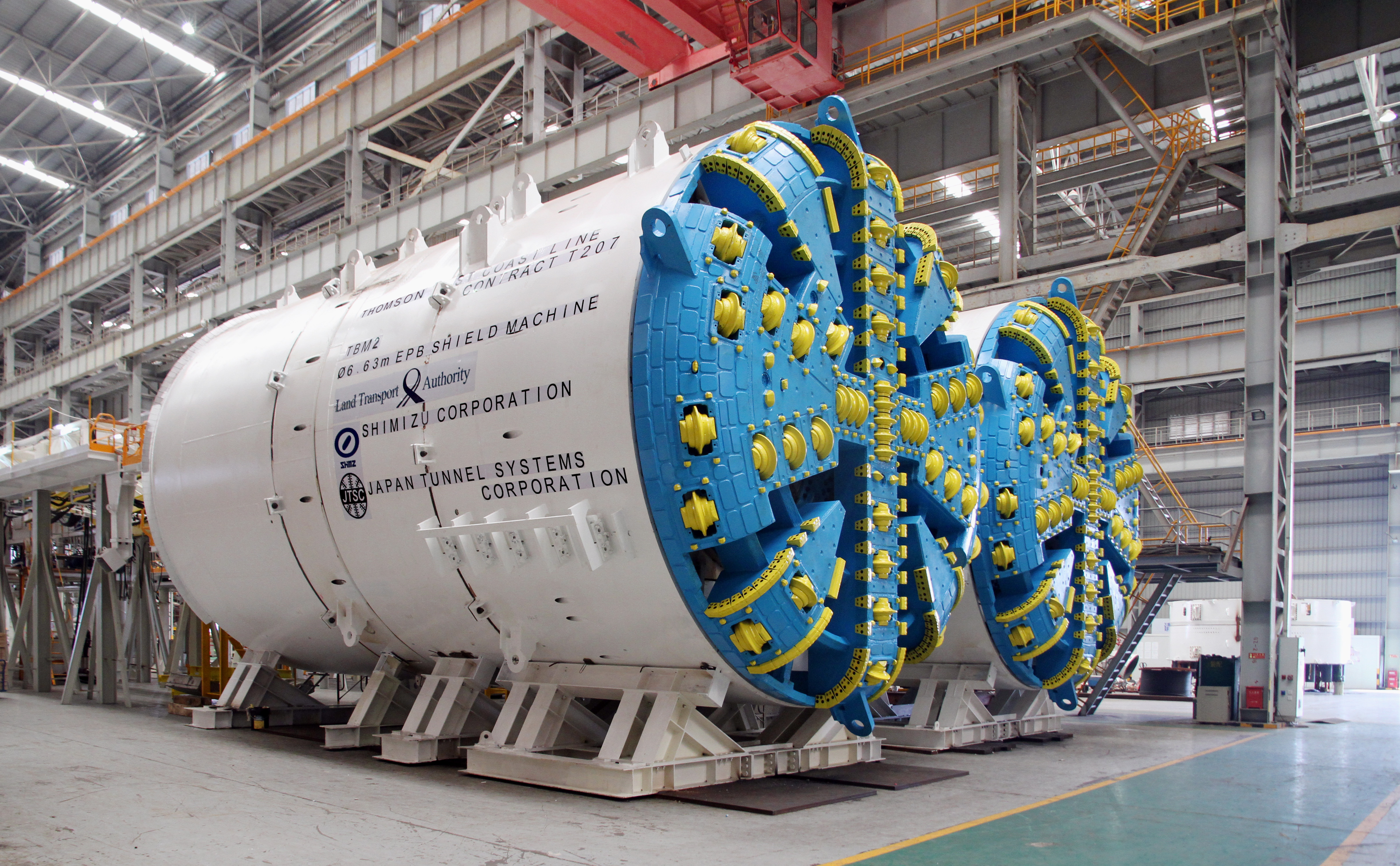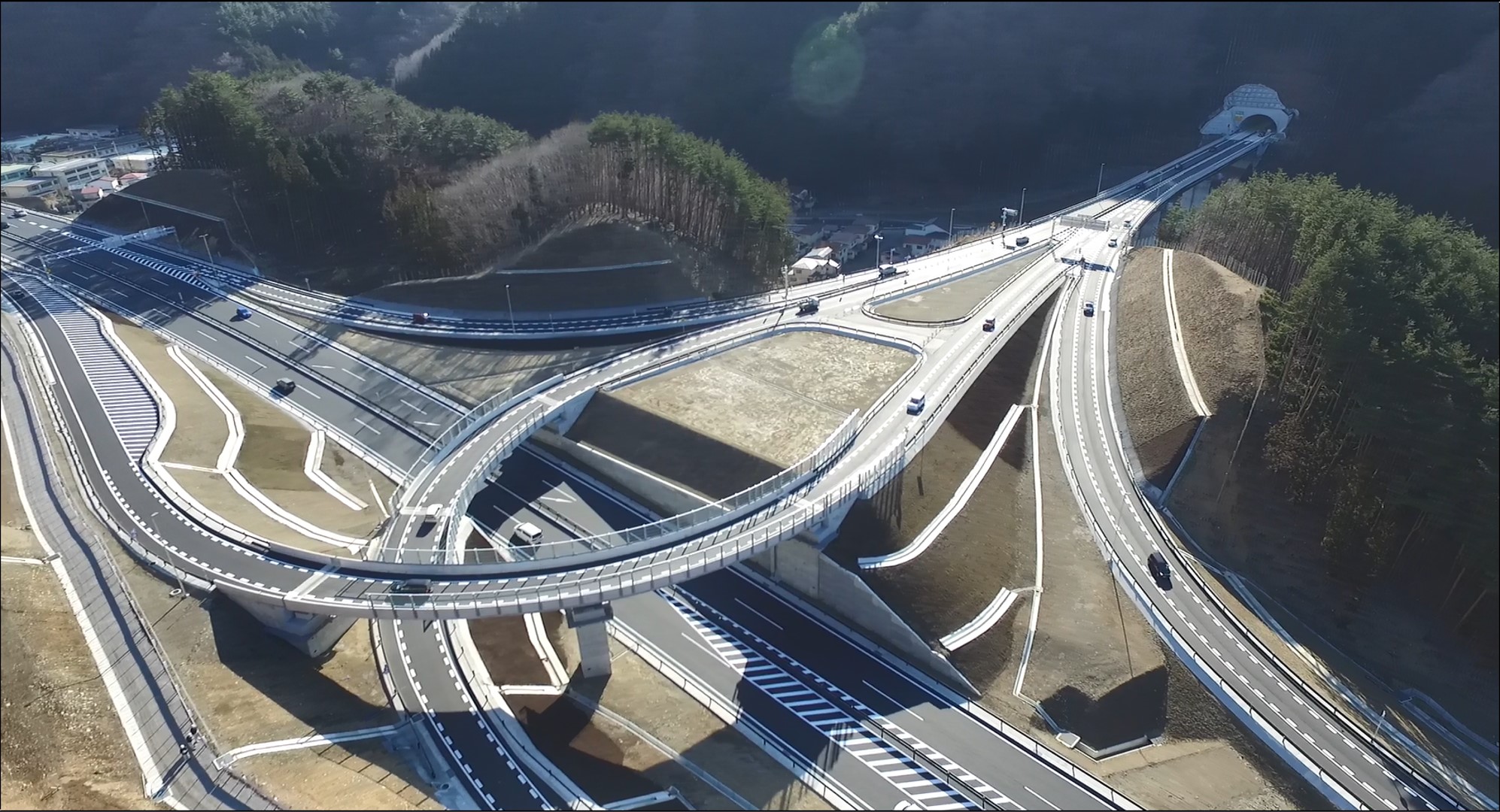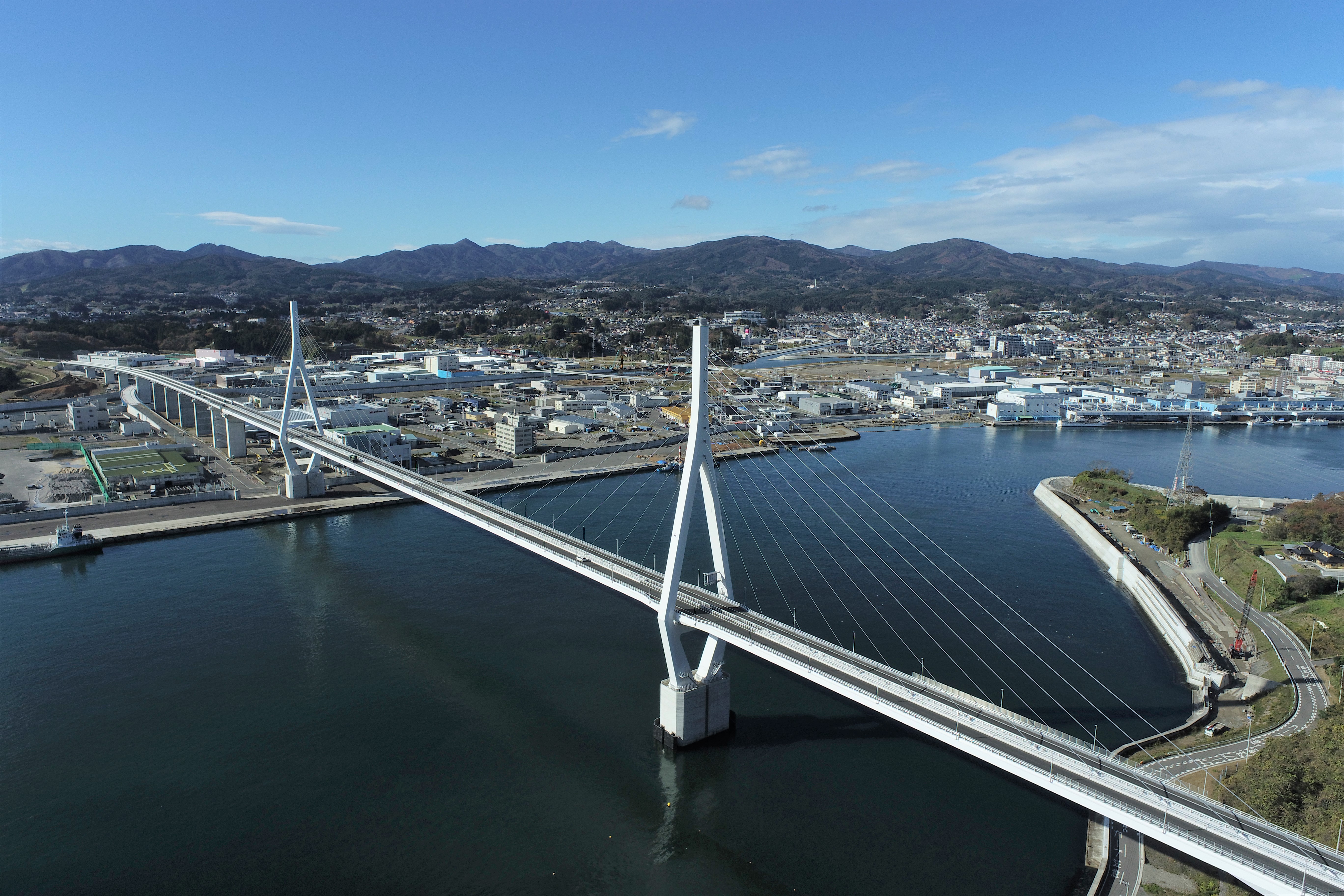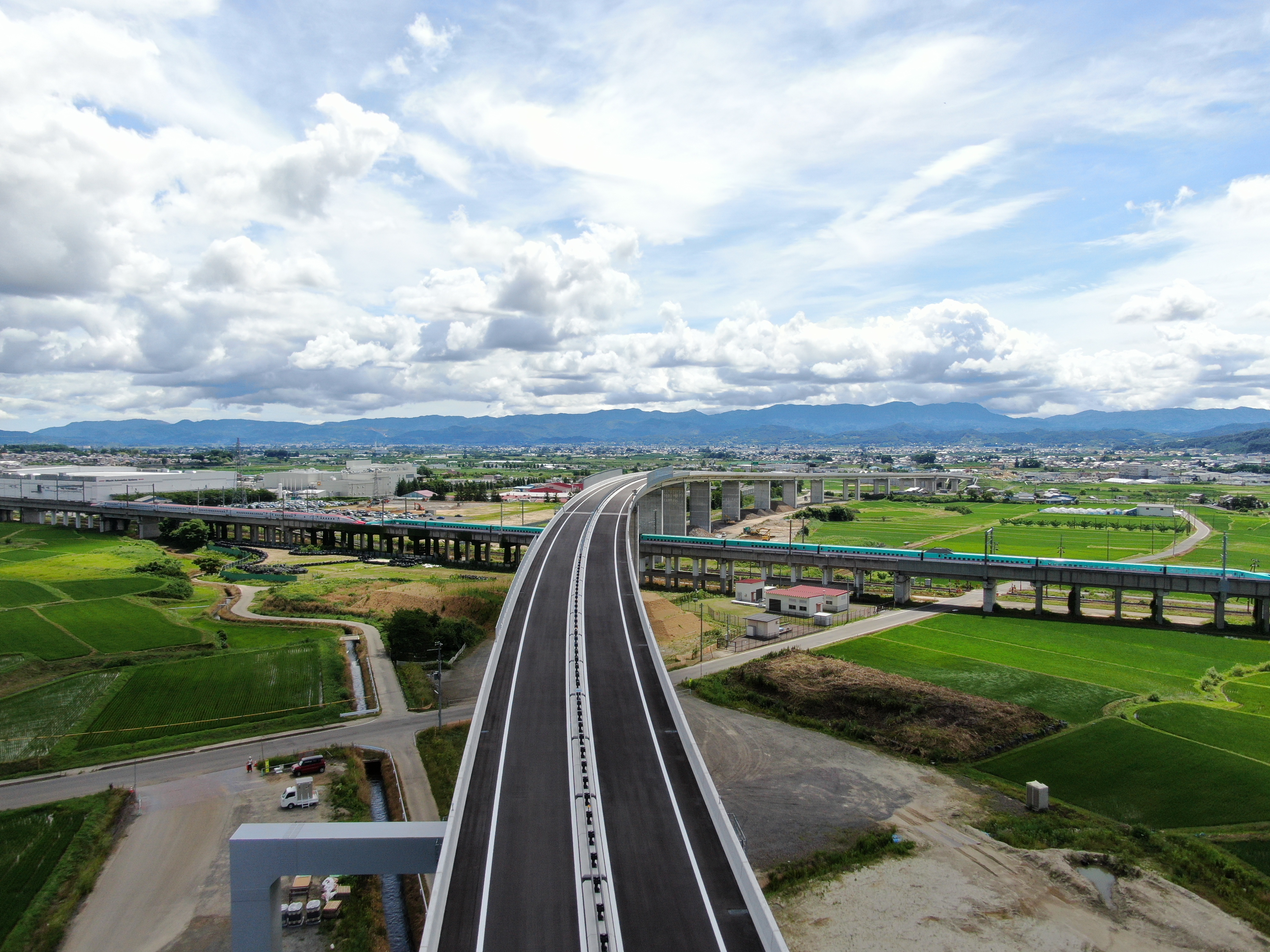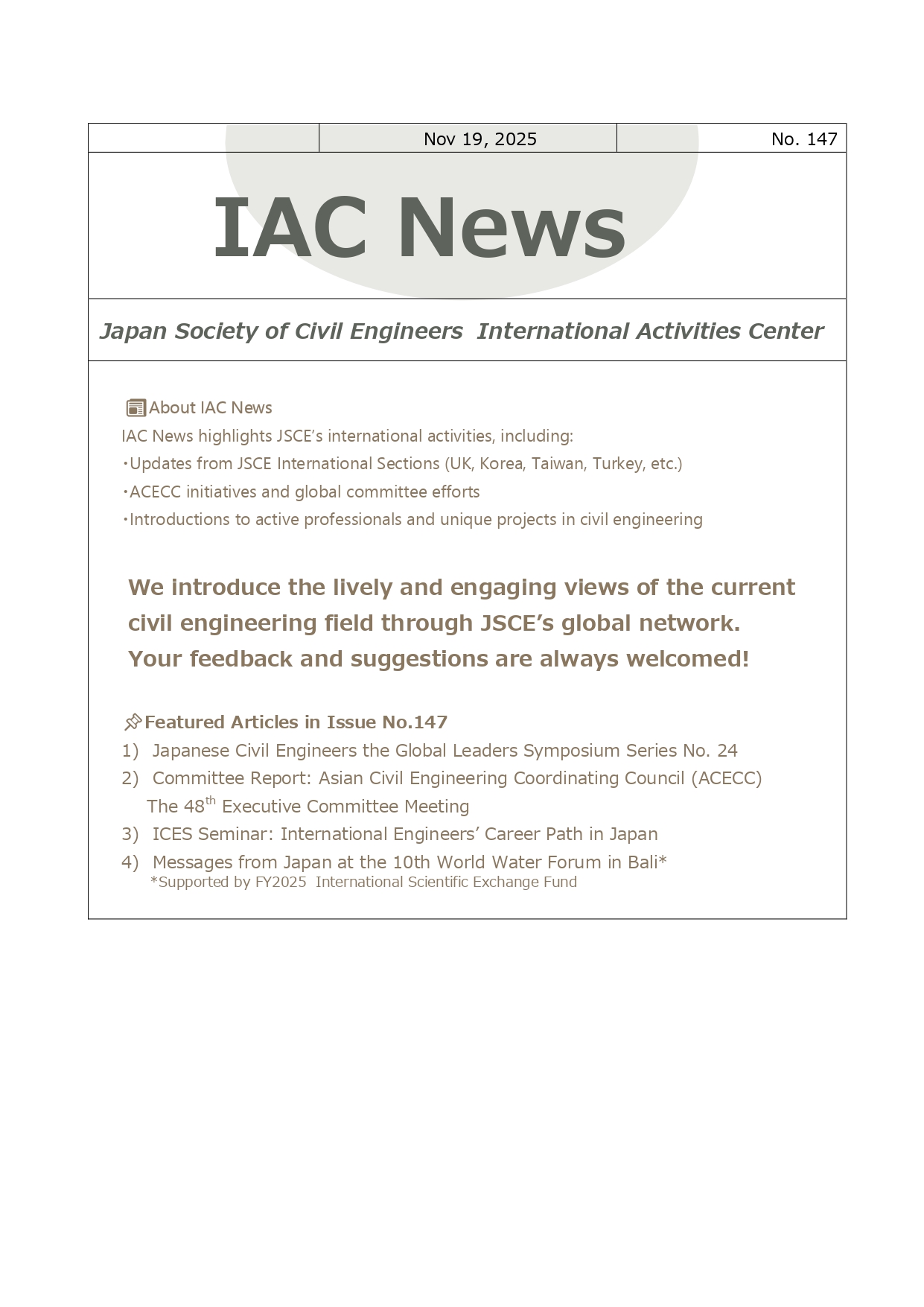2021 Outstanding Civil Engineering Achievement Award
[Group-1]
1. Rapid Construction and Development of Deck Replacements by Precast Technique for PC Composite Bridge
-Application of “CAP-SLAB” Method to Kamitagawa Bridge of the Chuo-Expressway-
- Central Nippon Expressway Co., Ltd.
- Obayashi Corporation
In order to achieve labour-saving and shortening construction period on the deck renewal projects of PC composite bridges, the unique precast PC deck, CAP-SLAB, has been developed and applied to Kamitagawa Bridge, the Chuo Expressway, which is 4 span continuous girders with total length of 125m. In addition, link-slabs instead of expansion bridge joints and full-precast concrete barrier were also adopted. These new technologies have enabled all-precast construction. The construction period was reduced to one-third of the original based on the cast-in situ method.
2. Construction of the reinforced concrete viaducts with the fully precasted system that improves productivity and reduces construction period (Fukui Kaihotsu Viaduct on the Hokuriku-Shinkansen Line)
- Japan Railway Construction, Transport and Technology Agency, Hokuriku Shinkansen Construction Bureau
- Obayashi Corp.
The project, Fukui Kaihotsu Viaduct on the Hokuriku-Shinkansen Line, was faced with challenges, which were advancing the business opening, narrow construction conditions, and the procurement difficulty with labors, materials and equipment due to the demands for the Tokyo Olympic Games.
To overcome the challenges, the fully precasted system was applied to the 11 RC viaducts’ construction as the first case of the railway construction projects in Japan.
The system contributes dramatical reduction on site workloads and construction duration comparing with the traditional in-situ construction method. In fact, labors and construction period in the project were reduced by 45% and up to 65% respectively compared with the traditional method.
3. ICT construction utilizing remote technology in the first mountain tunnel in Japan
(Tamashima Kasaoka Road Rokujoin Tunnel Construction)
- Ministry of Land, Infrastructure, Transport and Tourism Chugoku Regional Development Bureau Okayama National Highway Office
- HAZAMA ANDO Corp.
The Rokujoin Tunnel is a road tunnel with a length of L = 1,088m located in Asakuchi City, Okayama Prefecture. At the Rokujoin tunnel, we applied remote control technology for drill jumbo for the first time in Japan and worked on unmanned construction for drilling work at the face. In addition, at the Rokujoin tunnel, we worked on remote presence technology in inspection work, etc. to improve the efficiency of construction management. These efforts were highly evaluated as contributing significantly to the development of civil engineering technology, and were recognized as worthy of the Technology Award (Group I).
4. Japan national route 106, road construction project in Sokei district,
Tunneling with the use of “NATM management system” and “Concrete lining monitoring system”
- Sanriku National Highway Office, Tohoku Regional Bureau, Ministry of Land, Infrastructure, Transport and Tourism
- Tohoku branch office, Taisei Corp.
The road construction project in Sokei district including a tunnel applied two ICT technologies named “NATM management system” and “Concrete lining monitoring system” for excavation and lining works, respectively. The former system enabled to monitor and record remotely the operation situation of heavy machines and temporary installed facilities as well as the working environment. It contributed to specifying and solving the emergent problem promptly. The latter system visualized on smart devices filled zone and condition of fresh concrete casted in a moving formwork. Recorded data acquired by several kinds of sensors in those systems can be analyzed for not only tunneling performance enhancement but also maintenance activities.
5. First automated construction of sabo dams at disaster sites in Japan(Akadani No. 3 sabo dam construction)
- Kinki Regional Development Bureau, Ministry of Land, Infrastructure, Transport and Tourism
- Kii Mountains Sabo Office / Sediment Disaster Prevention Technology Center
- Kajima Construction Co., Ltd. Kansai Branch
In Japan's largest sabo project for river channel blockage, the introduction of unmanned construction that remotely controls heavy machinery is a condition for the construction of the No. 3 sabo dam located just below the slope where the slope re-collapses repeatedly three times.
In order to ensure safety against slope re-collapse and to construct quickly, the newly developed automated construction technology was added to the unmanned construction in the construction of the sabo dam, and it was applied to the construction work for the first time in Japan.
The automated construction technology for sabo dams established this time has contributed to the development of civil engineering technology by not only prompt disaster response but also improving productivity and promoting construction DX.
6. Improve safety at the downtown terminal station by eliminating the steep curved platform
‐Relocation of the JR Iidabashi Station platform using thorough mechanized construction‐
- East Japan Railway Company Tokyo Construction Office
- Tekken Corporation Maeda Corporation Joint Venture
- Totetsu Kogyo Corporation Tokyo Branch (Railway Track Maintenance Business)
- JR East Consultants Company
JR Iidabashi Station's existing platform is located on a steep curve. There is a large distance between the platform and the train, so in this project, the platform was relocated approximately 210m to a section with a gentler curve. Due to the platform relocation destinations were limited ,the vertical gradient of the platform relocation destination will be a steep slope. The track lowering and platform lowering construction was carried out to ease the slope of the track to improve safety and the productivity was improved dramatically. In addition, new technologies such as 3D models and track equipment monitoring were used and as a result, construction was completed in 1 year and 1 month, without any accidents.
7. Construction of high-quality depth underground structure in metropolitan area
- 1st Construction Office Tokyo Metropolitan Government
- Tokyo branch office, Taisei Corp.
This Construction is the road improvement project which is located between Shin-Ohashi-street and Tsukiji-Ohashi (extension 572m) of Ring Road No.2 Main structure is the ventilation station separated by four-story and be located below a deep ground with a maximum depth 34m.
The site is closed to Shin-Ohashi-street, which has a lot of traffic. In addition, there are many obstructions under the ground due to the vacated site used as the Tsukiji Market. Under such circumstances, it is a challenge to construct a deep underground structure without any problem.
This paper shows various construction ideas that have completed high-quality large-scale underground structures.
8. Advanced Highway Bridge Slab Replacement Utilizing State-of-the-Art Technologies (Application of Hydro-Jet RD Removal & Flat UHPFRC Renewal Slabs to Moriguchi Route, Hanshin Expressway)
- Hanshin Expressway Co., Ltd., Business and Maintenance Management Headquarters
- Tobishima Corp., Osaka Branch
- Kajima Corp., Kansai Branch
Numerous highway bridge slabs are deteriorated and must be renewed in Japan since they have been used under severe conditions for over 40 years. Therefore, advanced technologies are required in order to replace a large number of deck slabs smoothly. Hydro-Jet RD Removal using water jet minimizes social impact, among highly restricted urban environment, because deck slabs can be removed two times faster than conventional method. Flat UHPFRC (Ultra-High Performance Fiber Reinforced Concrete) slabs drastically improve deck slab durability due to their material and structural advantages. These state-of-the-art technologies will be widely used for future deck slab renewal and deserve JSCE technical award.
9. Productivity improvement and Quality control optimization using Construction Information Modeling/Management (CIM)
(H29-32 Arakawa River Waterway Tunnel Construction Site)
- Arakawa Upstream River Office, Kanto Regional Development Bureau of the Ministry of Land, Infrastructure, Transport and Tourism (MLIT)
- TAISEI Corp.
Construction Information Modeling/Management (CIM) was applied to visualize underground obstacle and construction procedure of waterway tunnel structure. 3-dimensional information using CIM model made it easier to grasp the position of underground obstacles and structures, which provided us prompt decision making. Information during construction such as concrete work, earth work and soil improvement work were tagged to CIM model to utilize for operation and maintenance. Any information such as photos, documents, and drawings can be added to CIM model without restriction. This system enables us to share information at the planning stage, construction stage, and maintenance stage between manufacturer, contractor, and owner on a common platform in a unified manner.
10. Technological innovation of the PS anchor in the Kawamata Dam rock foundation
-Establishment of rock reinforcement technology with rock anchors-
- Ministry of Land, Infrastructure, Transportation and Tourism. Kanto Regional Development Bureau, Kinugawa Integrated Dam Control Office
- Japan Dam Engineering Center
- Nippon Koei Co.,Ltd
- OBAYASHI Corp.
Kawamata Dam is an arch dam with a height of 117m completed in 1966 in Nikko City, Tochigi Prefecture. At the time of construction, the world's largest PS (prestress) anchor class was established to reinforce the foundation rock. However, now after 50 years of construction, the need for foundation rock reinforcement has increased. This project is the first large-scale rock anchor renewal in Japan designed and constructed by innovative technology.
As technological innovations, a tension method called the intermediate unloading method, establishment of double anticorrosion structure with long-term durability, high-precision rock drilling and tension management, a special hanger for transporting tendons, by adopting measuring devices with excellent long-term durability were devised.
By these technological innovations, we have achieved high durability and high quality of PS anchors in this project.
11. The mountain tunnelling project under strong ground pressure in serpentinite
- Otonaka Tunnel in National road No.40
- Hokkaido Regional Development Bureau, Asahikawa Development and Construction Department, Shibetsu Road Office
- Joint venture of Shimizu Corp., Itogumi Construction Co., Ltd. and Iwakura Construction Co., Ltd.
In the Otonaka Tunnel, large-scale deformation occurred in serpentinite area under the intense ground pressure rarely seen in tunneling history. In the deformed section, a circular triple support structure with an early cross-sectional closure was designed. In the newly excavated section with a fault zone, the advanced central pilot tunneling method was adopted. To design a lining subjected to time-dependent displacement, a reproducing method for time-dependent behavior and a numerical analysis model were developed. In this way, this project overcame the technical challenges through a variety of advanced efforts and made a significant contribution to the development of tunneling engineering.
12. The Urban Restoration Project in Satozuka district, Kiyota, Sapporo
- Urban Areas Restoration Office City of Sapporo
- Penta-Ocean and Ito joint venture
- Fukken Gijyutsu Consultants Co., Ltd.
- The technical review meetings for urban restoration in Satozuka district, Kiyota, Sapporo
- The technical advisors to restoration in Satozuka district, Kiyota, Sapporo
SAFER Kitami Institute of Technology
As a result of the 2018 Hokkaido Iburi Earthquake, the Satozuka district of Kiyota Ward in Sapporo was suffered tremendous damage. After the earthquake, about half of 140 residents were forced to evacuate, and the existence and sustainability of the local community was threatened. Only two years after the earthquake, restoration work was completed, providing information proactively to support rebuilding homes and personalized follow-up services for disaster victims at a local office in the disaster area. As a result, over 80% of disaster victims wished to rebuild their houses in the area, and most of the reconstruction of their houses was finished after two years and a half from the earthquake, leading to a speedy restoration of urban areas.
13. Improving the efficiency of dam concrete placement by handing down the technology utilizing digital technology
―Kabagawa dam construction work―
- Kagawa Pref. River and Sediment Control Division
- Taisei・Tobishima・Murakami Specified Construction Joint Venture
In the dam site, handing down the technology to the young engineers becomes difficult with the decrease of the skilled engineers. In order to solve this problem, at the construction site of Kabakawa dam located in Kagawa Prefecture, masterly skills were made into data using ICT. By educating young engineers using this, productivity improvement and quality assurance were achieved. Fundamental changes in handing down the technology by ICT are the essence of DX, and since it contributes greatly to the sustainable development of the construction industry and the promotion of DX, it recognized worth technology award.
14. Measures Applied for Productivity Improvement of Concrete Bridge Construction
- Adoption of Steel Pipe-Concrete Composite Piers and Rational Construction Method for Pier Segments and the Other-
- Central Nippon Expressway Co., Ltd.Tokyo Branch Office
- Obayashi Corporation Tokyo Main Office
Nakajima Viaduct which is seven continuous PC box girders with ca. 500m bridge long is located between Shin-Hatano IC and Shin-Gotemba IC of the New Tomei Expressway.
In this project, to reduce the number of the labors and shorten the construction period was required because of the recent shortage of construction workers and the busy period due to the 2020 Tokyo Olympics.
Thus three measures have been taken in this project. The 1st is to change the RC hollow structure to the steel pipe-concrete composite for the piers. The second is to apply the rational construction method for the pier segments. The third is to use the new anti-corrosion reinforcing steels for the concrete barriers.
[Group-2]
1. The Construction of Koishiwaragawa Dam
-The challenge of developing new quality control methods for the impermeable core embankment work -
- Japan Water Agency
The Koishiwaragawa dam in Kyushu region was constructed with the efficient and advanced technology on the impermeable core embankment work and achieved the high speed work compared to existing dams. In the process of excavating, selecting, processing the materials of the rockfill dam construction, the fully quality control using ICT and works by ICT were implemented.
Through this project, the great contribution for innovation of civil engineering technology was recognized. In addition, the early completion of dam construction was useful to reduce and prevent the flood damage of downstream against the enormous rainfall in 2020 effectively.
2. International Marine Container Terminal Development Project,
Minami Honmoku Pier MC-4, Port of Yokohama
- Keihin Port Development Office, Kanto Regional Development Bureau, Ministry of Land, Infrastructure, Transport and Tourism
- Port and Harbor Bureau, City of Yokohama
- Yokohama-Kawasaki International Port Co., Ltd.
Construction of Minami Honmoku Pier MC-4, Port of Yokohama, has been completed under the severe conditions of deep water and soft ground.
This high standard container terminal with a quay depth of 18 meters (largest in Japan and the only one of its type) can accommodate the world's largest container ships.
As a result, Minami Honmoku Pier has become a state-of-the-art pier that can handle the increase in container cargo and the increase in size of container ships as a new distribution base for Yokohama Port.
3. The Container Terminal(Y2) Development Project of Outer Central Breakwater Area, Port of Tokyo
- Tokyo Port Office, Kanto Regional Development Bureau, MLIT
- Bureau of Port and Harbor, Tokyo Metropolitan Government
- Tokyo Port Terminal Corp.
In this project, a new container terminal (Y2) with a quay with a depth of 16 m and an extension of 400 m was constructed to cope with the increase in cargo demand, the increase in size of container ships, and large-scale earthquakes.
In terms of construction, there were strict restrictions such as the aviation restrictions at HANEDA Airport, the Navigation Passage No.1 where many large vessels navigate are close, and there is a soft geological layers.
In addition, container cranes installed on the quay needed to comply with aviation restrictions and large container ships.
This Shuttle Boom Type Container Crane, which also has a seismic isolation function, weighs about twice as much as a normal container crane. Y2 Container Terminal was designed and constructed under these extremely strict conditions.
The main quay structure is a jacket-type pier, and the ground behind the revetment has been improved to increase the strength of the ground and prevent liquefaction.
Pile driving and jacket installation on the quay did not violate aviation restrictions, and dredging of navigation passage and anchorage area were carried out while ensuring the entry and exit of ships.
These works required construction studies and close coordination with sea area users in advance, and the construction was completed safely by overcoming various severe conditions such as aviation operation and ship navigation without affecting the surrounding area. Y2 Container Terminal started service in March 2020.
4. Hiroshima Sediment Disaster Emergency Project on August 20, 2014(Sabo Project to ensure safety local infrastructure)
- Hiroshima Western mountain range Sabo Office, Chugoku Regional Development Bureau, Ministry of Land, Infrastructure, Transport and Tourism
As the countermeasures for catastrophic sediment disasters in Hiroshima city, caused by heavy rains on August 20, Sabo Office had constructed 40 Sabo dams in short period. Just after the disaster, Office had installed surveillance cameras and debris flow alarm systems (non-structural measure) and constructed resilient wire nets (structural measure). After that, in order to construct Sabo dams emergently, Office had made the most of technical methods, such as Sabo soil cement and residual form which enable efficient works.
In addition, Office had hold variaous activities targeting local residents, for example, construction on-site tours and ceremonies to pass on the disaster memories, to promote its project with the reconstruction of the disaster area.
5. New Ulaanbaatar International Airport Construction and Operation Project in the Mongolia
- Civil Aviation Bureau, Ministry of Land, Infrastructure, Transport and Tourism.
- Japan International Cooperation Agency.
- Oriental Consultants Global Co., Ltd.
- Azusa Sekkei Co., Ltd.
- Mitsubishi Corp.
- Chiyoda Corp.
- Narita International Airport Corp.
- Japan Airport Terminal Co.,Ltd.
- Jalux Inc.
- Nomura Research Institute, Ltd.
- Japan Radio Air Navigation Systems Association.
- Air Traffic Control Association, Japan.
The New Ulaanbaatar International Airport Construction and Operation Project aimed to construct a new capital airport having a 3,600m runway and new terminal area with 2 million annual passenger capacity. It is a landmark project implemented through all-Japan collaboration by using Japanese loans and participation of Japanese companies.
The technical features of the project include: The ground elevation difference around the passenger terminal building was resolved by adopting the complex floor structure. A large-scale slipform finisher was used to construct a wide area of concrete pavement within a limited construction period. In terms of airport operations, Japanese experts provided technical assistance in airport privatization, airport operations and air traffic control.
6. Integrated construction work on the Rikuzentakata earthquake restoration project
- City of Rikuzentakata
- Urban Renaissance Agency
- Rikuzentakata City Earthquake Reconstruction Project Joint
Venture
This project is an earthquake reconstruction in Rikuzentakata City, devastated by the Great East Japan Earthquake.
The huge scale earthwork consists of excavation, transportation, and filling of approximately 12 million m3 over 300 ha, and rapid construction was required for earthquake reconstruction.
A large belt conveyor was adopted for approximately 5 million m3 of earth transportation process and shortened the process by about six years. Furthermore, the fast-track method in the residents’ relocation plan to higher ground enabled efficient project execution and early reconstruction. Therefore, this project should be left for posterity as a model case of a large-scale reconstruction project and worthy of the Outstanding Civil Engineering Achievement Award.
7. Integrated disaster recovery project through public-private cooperation in Hakone, one of Japan's leading tourist destinations
(Hakone Tozan Railway: Early restoration project of severely damaged railroad tracks)
- Kanagawa Prefectural Government, Prefectural Land Development Bureau
- Kanagawa Prefectural Government, Environmental Agricultural Administration Bureau
- Hakone Tozan Railway Co., Ltd.
- Shimizu Corp.
- Nishimatsu Construction Co., Ltd.
The Hakone Tozan Railway was forced to suspend operations due to severe damage caused by the heaviest rainfall ever recorded in the history of the East Japan Typhoon (Typhoon No. 19) in 2019.
The government, railroad operator, and construction company worked together with the cooperation of local residents in order to resume operations at the earliest possible date.
This was a disaster recovery project in which the entire community worked together to shorten the period of suspension from more than a year initially expected to nine months.
8. KIX Disaster Resilience Enhancement Project
- Kansai Airports
This project was triggered by the damage Kansai International Airport had to go through and the social impact of losing its airport functions by Typhoon Jebi in 2018. Disaster prevention functions, such as countermeasures for wave overtopping at the seawall and unexpected flooding, were reinforced in such a short period of about three years after the disaster.
While the need to respond to natural disasters caused by global warming increases, this project was recognized as contributing to the future development of coastal and infrastructure development in our country, and thus was deemed worthy of the outstanding civil engineering achievement award.
9. Completion of lane widening project (2lane to 4lane) in Joban Expressway
- East Nippon Expressway Co.,Ltd. Tohoku Regional Head Office
- East Nippon Expressway Co.,Ltd. Sendai Construction Office
- East Nippon Expressway Co.,Ltd. Iwaki Construction Office
- East Nippon Expressway Co.,Ltd. Iwaki Operation Office
Since the operation of Joban Expressway (entirely opened in March 2015), the traffic volume has significantly increased and the traffic congestion has happened accordingly especially in 2 lane sections.
Lane widening project was decided at the 2 lane sections, which is remarkable traffic congestion area, in June 2016.
This project was required to complete in short periods of about 5 years, because the great efficiency is expected by early implementation.
Especially, this project contributes the disaster recovery in Fukushima Prefecture greatly, because conveyance of decontaminated materials in Fukushima to the interim storage facility is accelerated.
This project had the wide variety challenges to the completion, and overcame those problems by many ingenuity method with unpreceded speed of 5 years.
10. Safe, secure, and comfort station development towards success of the Tokyo 2020 Olympic Games and inheriting legacy for regional society
- East Japan Railway Company
This project is to conduct station improvement construction, such as expansion of barrier free and safety equipment or installing guidance sign for customers, in order to promote smooth management and to build momentum for Tokyo 2020 Olympic Games.
We have resolved issue of renovating existing station which has land limitations, by construction of artificial ground above railway track or by creating a new space with an effort of replacing station facilities.
Over 60 stations were renovated and guidance sign were installed to 285 stations during the project. This will lead to the development of a safe, secure and sustainable Japanese society as a legacy after 2020. The project was admitted as technology award from point of view on both regional society growth and civil engineering technology development.
11. Singapore MRT Thomson-East Coast Line Contract T207
- Land Transport Authority, Republic of Singapore
- Shimizu Corporation
Contract T207 of Singapore MRT Thomson-East Coast Line mainly focused on the simultaneous excavation by 4 Tunnel Boring Machines.
Despite the exceptional conditions such as continuous excavation underneath expressway and wide ranged face condition from soft soil to hard rock, the project was completed without accidents using advanced excavation management system and diverse staffing. The project was highly evaluated for its significant contribution to the development of civil engineering technology in Singapore, including improvement of the BIM application and was recognized as a great project with a high degree of contribution to strengthen Singapore's transportation hub function and thus worthy of the Technology Award.
12. Reconstruction road-reconstruction support road
(leading Project for Reconstruction from the Great East Japan Earthquake)
- Tohoku Regional Development Bureau Road Section
- Aomori River and National Highway Office
- Iwate River and National Highway office
- Sanriku National Highway Office
- Minamisanriku Coastal National Highway Office
- Sendai River and National Highway Office
- Fukushima River and National Highway Office
- Iwaki National Highway Office
Reconstruction road-Reconstruction support road; total length is 570km, are placed as a leading Project for Reconstruction from the Great East Japan Earthquake.
To construct these roads quickly and smoothly, Tohoku Regional Development Bureau and National Highway Offices established “The Reconstruction Conference”. Also, they introduced Public-Private Partnerships in technical capabilities to manage projects efficiently. As a result, they could cooperate with many local governments, construction world. Therefore, they could construct these roads completely in 10 years.
This speediness and inventiveness deserve the technology prize.

